











This Pesach, discover the secret to Pesach

COMING SOON!
From mouthwatering starters to showstopping desserts, Lieber’s recipes combine the finest ingredients with expert tips, bringing tradition, fresh flavors and family favorites to your table.




In the world of Jewish music, few artists capture the essence of a story quite like Joey Newcomb. His newest album features a song with a particularly meaningful backstory, one that many Baltimoreans will immediately connect with. Heiligeh Rabbi Lefkowitz was inspired by a recent trip to Morocco, where Joey encountered a Yid who never put his gemara down.
While the group visited kevarim and historical sites, singing and dancing along the way, one man stood to the side, fully immersed in learning. It didn’t matter where they were- on the bus, in a shul, or at a centuries-old Jewish landmark- his eyes never left the gemara in his hands. Watching him, Joey couldn’t help but wonder: Why was he even on this trip? The only sights he seemed to take in were the words of his seforim. Eventually, he turned to someone and asked who this person was. “Rabbi Lefkowitz,” came the answer. That was all Joey needed. He went to the back of the bus, started singing, and soon the entire group was joining in, celebrating the presence of this remarkable masmid
For those who know him, the story comes as no surprise. Because Rabbi Lefkowitz’s real song is the song of Torahone he has been singing his entire life.
Rabbi Hirsch Lefkowitz is a name well-known to those who lived in Baltimore during the 40-plus years he spent in the city. He was, by profession, a baalabos, working at the Social Security Administration. But anyone who knows him understands that his work does not define him. If you see him at his desk, a sefer is open. If you see him at shul, a sefer is open. If you visit his home, there’s no doubt- a sefer is open. His life is one of learning, a relentless pursuit of Torah knowledge, not for accolades or recognition, but because that’s simply who he is.
He and his wife, Esther A”H, built a home deeply rooted in Torah values, raising a family with the same dedication. Though he never sought leadership or public roles, his reputation as a talmid chacham was well known. Then, about 20 years ago, as the Greenspring neighborhood began to expand, a group of baalei batim saw in Rabbi Lefkowitz something unique. They recognized that his
learning was not only remarkable in its consistency but had the power to inspire others. They urged him to step into a new role- as a Rav
Reluctantly, he agreed, becoming the Rav of Heichal Melech, a small but serious makom Torah. His shiurim and drashos were known for their depth, but what left the deepest impact on his kehilla was his hasmada. Here was a Rav who wasn’t just giving over Torah, he was living it every second. It wasn’t only his words that inspired people, but the way he carried himself, the way he never wasted a moment, the way he made it clear, without ever saying so, that a life of Torah was the only life worth living.
Every Shabbos, he would walk from Upper Park Heights to Greenspring, sometimes multiple times, to be with his kehilla. No shortcuts, no compromises. Rain or shine, hot or cold, he made the journey, leading by example. Heichal Melech did not last forever; after his wife’s passing, Rabbi Lefkowitz eventually remarried and moved to New York, where he lives today. But his impact remains. For those who were fortunate enough to daven with him, learn from him, or even just see him lost in a sefer, the memory of his unwavering dedication continues to inspire.
And so, when Joey Newcomb met Rabbi Lefkowitz on that trip, it was not the first time this masmid had left an impression. It was simply another moment in a lifetime of learning, another instance where his very presence conveyed what a life of Torah truly looks like. For many, a journey to Morocco is a chance to witness Jewish history and connect with the past. For Rabbi Lefkowitz, there was no need; his connection to Torah, uninterrupted and unwavering, is his history, his past, present, and future.
The song that Joey composed captures a single moment, but the real song of Rabbi Lefkowitz is one he has been singing for decades. It is the song of Torah that never stops, the melody of a life devoted to learning. And for those who know him, his learning is the most beautiful song of all.
Have a peaceful Shabbos!
Aaron M. Friedman
Send us your: community events, articles & photos, and mazal tovs to editor@baltimorejewishhome.com to be featured in coming editions!
Comfort Year-Round:

Save Big on Energy Costs:
Cut your heating and cooling bills by 30-50% and make your HVAC system work smarter, not harder.
Breathe Better:
Enjoy improved air quality with reduced drafts and outdoor pollutants, creating a healthier living environment.


What an incredible month for the talmidim, rebbeim, and parents of Yeshivas Mekor Chaim (YMC)! Earlier this month, YMC participated in its first-ever Crowdsource fundraising campaign. With a goal of $120,000, the boys created individual and grade-level teams to help their school raise funds in its first-ever, exhilarating campaign. The level of commitment was inspiring. After a two day-call center and week-long campaign effort, the yeshiva reached and exceeded its goal with the help of numerous community contributions and the generosity of our campaign matchers. Rewarded with pizza lunches and YMC branded ski beanies, the boys enjoyed a celebratory ski trip to


Liberty Mountain Resort as a recognition of their efforts.
As always, YMC strives to infuse Torah and spirituality into every school endeavor. On Thursday, March 6, ז’ אדר, the yahrzeit of Moshe Rabbeinu, the yeshiva culminated the campaign effort with a Mega Mishmar evening of learning, held in the new SOTC social hall. Participants of the Mega Mishmar learning event, which included YMC talmidim, rebbeim, fathers, and grandfathers, were mesayim Maseches Megilla, while additional community members joined the exuberant learning by studying a topic of their own choosing. The energy was palpable. Tables were set with YMC branded folders,
pens and water bottles. Each talmid and his chavrusa received an individually curated portion of the masechta to study. The hum of learning could be heard throughout the room, as each chavrusa strived to finish their portion so that the collective group could be mesayaim by the end of the evening. After words of Divrei Bracha from Rabbi Shmuel Silber, YMC Dean, and a Dvar Torah from YMC senior Yaakov Meister, Sruli Levin, a 9th grade talmid, was mesayaim, while Yitzi Weiner, an 11the grade talmid, recited the hadran with great excitement and a sense of fulfillment. The group joyously broke out into song and dance led by the musical accompaniment of Eli Cohen, Moshe Abramson, Dovi Ziffer and Zevi Dan-
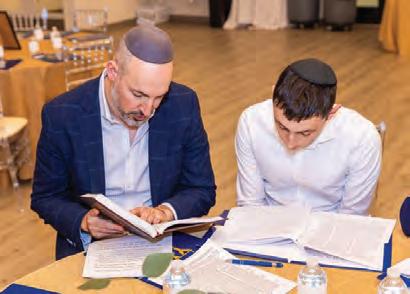


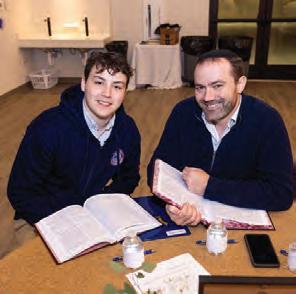
By: BJLife Newsroom
iel. YMC’s own Moshe Reitberger played guitar alongside the melodious group. After enjoying a delicious Knish Shop Erev Shabbos Toameha spread, the boys, fathers, and rebbeim spent the evening dancing joyously in celebration of this incredible learning effort. The evening concluded with inspiring words from Rabbi Uri Grosberg, YMC Menahel, and a soulful kumzitz enjoyed by all attendees.
A special thank you to YMC Executive Director Mrs. Rivki Fialkoff, the YMC Rebbeim who worked tirelessly to coordinate the learning for the Mega Mishmar event, and the dedicated team of parent volunteers who made the evening an incredible success.
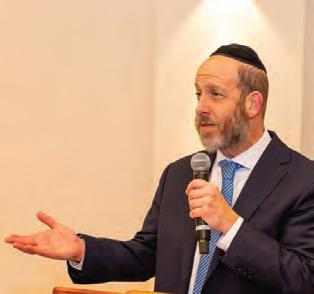




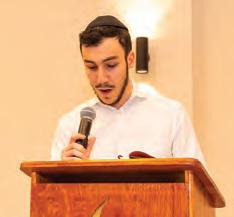

Torah Institute hosted the annual Center for Initiatives in Jewish Education (CIJE) interschool robotics competition for middle school students. Talmidim from boys’ schools across Baltimore, Silver Spring, and even as far as Cherry Hill and Passaic came together to compete in a series
of challenges that showcased the skills they had developed in building and operating various robots. In the end, the host school, Torah Institute, emerged as the champions. A big thank you to all the principals, teachers, and CIJE for their dedication and collaboration in making this event a success!


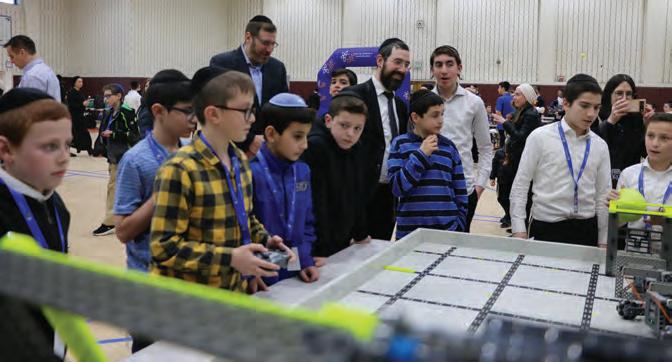
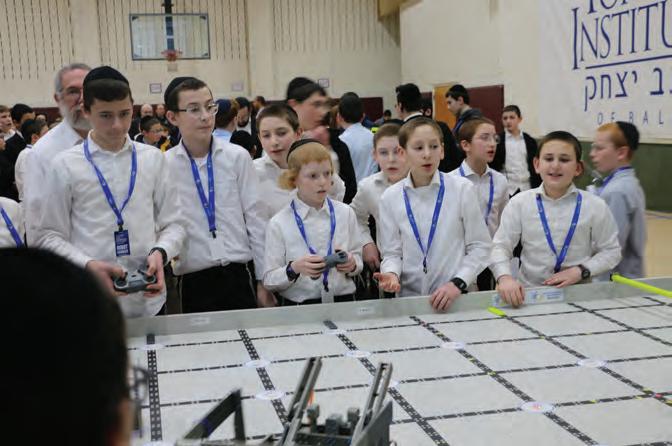





The annual Derech Chaim (HaRav Pinchas Gross)
matzah baking trip occurred in Lakewood, with 20 men and 15 young men participating in baking matzos for several hours. The participants had the zechus of hearing a shmuz from HaRav Nachum Binder, Rav of Khal Hampshire Heights, Lakewood, NJ.

By: BJLife Newsroom

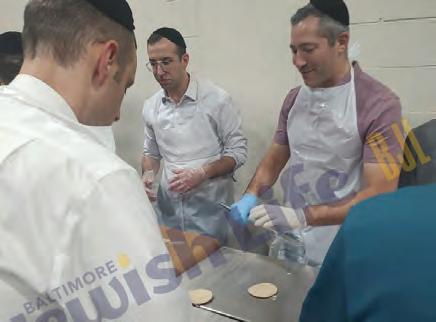
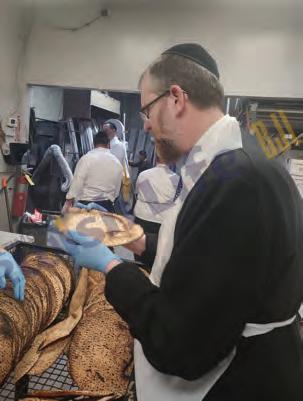
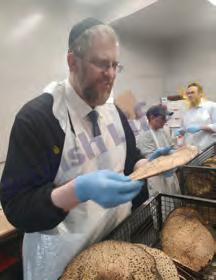

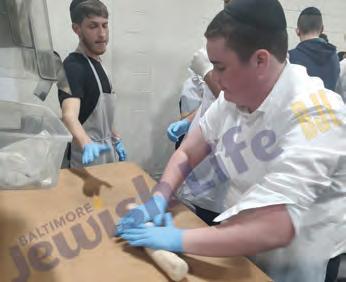
MARCH 24TH - MARCH 28TH
Monday March 24th Wednesday March 26th
9:30 am
Yoga with Deborah Bandos
10:00 am
Baking with Yehudis
11:00 am
Discussion Group with Rabbi KarpParshas Vayakhel Dilemmas
1:00 pm
Arts & Crafts with Shifra
2:00 pm
Music with Mr. Fried
Tuesday March 25th
9:30 am
Yoga with Deborah Bandos
10:15 am
Anagrams with Malka Zweig
11:00 am
Discussion Group with Rabbi KarpGreat Women who did for the State of Israel
1:00 pm
BINGO
1:45 pm
Guitar with Yossi K
9:30 am
Yoga with Deborah Bandos
10:15 am
Anagrams with Malka Zweig
10:30 am
Bais Yaakov Middle School Visit
11:00 am
Discussion Group with Rabbi Karp- Questions of Hashkafa and Emuna
1:00 pm
Arts & Crafts with Shifra
1:45 pm
Guitar with Yossi K
Thursday March 27th
9:30 am
Yoga with Deborah Bandos
10:15 am
Anagrams with Malka Zweig
11:00 am
Discussion Group with Rabbi Karp- Fascinating Hilchos Brochos
1:00 pm
Arts & Crafts with Shifra
1:45 pm
Guitar with Yossi K
Friday March 28th
9:30 am
Yoga with Deborah Bandos
10:00 am
Baking with Yehudis
11:00 am
Discussion Group with Rabbi KarpNews from Israel and Parshas Pekudai overview
1:00 pm
Music with Aharon Grayson


Rabbi Yechiel Spero Makes the Haggadah More Meaningful for Teens... and Us All!
At the Seder, we are tasked to bring the Haggadah to life through the retelling of Yetzias Mitzrayim. We inspire, and our children become inspired. And who better to help both parents and teens reach meaningful inspiration than master storyteller Rabbi Yechiel Spero? Also in this series: A Most Meaningful Tishah B’Av
EDITION by Rabbi Mordechai Lebhar
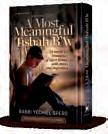

Rabbi Nachman Seltzer blends classic Torah commentaries and inspiring contemporary stories to bring your Sedarim to a whole new level.
The Abuchatzeira Legacy Haggadah brings the wisdom of Abir Yaakov, Rabbi Yitzchak Hy"d, Ateret Rosheinu, Baba Sali, Baba Meir, and Rabbi David Chai to your Seder table. The fascinating and unique commentary based on the writings of this legendary family, along with the mesmerizing stories of humility, compassion, and miracles, will transform and elevate your seder.

By: BJLife Newsroom
Construction on the Shearith Israel mikvah expansion project is progressing steadily. Significant strides have been made, including the completion of most of the foundation work and the foundations for the mikvah’s boros. Advanced construction techniques are being employed to ensure the structure’s long-term durability. These include
enhanced drainage and waterproofing systems, specialized concrete materials, and extra foundational layers for the boros.
In the coming weeks, the building’s structure is expected to start taking shape, marking an exciting milestone in the project’s development and bringing the community closer to realizing this important addition.


Many groups visit local assisted living homes and nursing homes to help celebrate the holidays. But Tobias’s Tent took it up a notch this Purim holiday. They visited Sterling Care Assisted Living residents rooms (with permission) and decorated them with posters, streamers, and balloons in honor of Purim.
Special thank you to Rabbi Shlomo Bergmann of Tobias’s Tent, the Bais Yaakov girls who created the signs, and the Torah Institute boys who did the work!
Mi
kiamcha Yisrael!


































The boys of BCL had an incredible time at SkyZone celebrating their achievement of 3 consecutive chesed week wins! With endless pizza and non-stop jumping, it was definitely a night to remember. Week 4 of the
Baltimore Chesed League was filled with impactful acts of kindness as teams visited assisted living facilities, bringing joy to the elderly, and cleaned up the costume Gemach after Purim. With Pesach approaching, the boys prepared food boxes for


deliveries, organized a food pantry and even made matzah, providing for those who need extra support. Each act of chesed brought them closer to qualifying for the end-of-season banquet, where prizes sponsored by Chesapeake Urology and Union





Bridge Family Dentistry await! Through their tireless efforts, these boys continue to demonstrate the power of kindness and the strength of community, making a lasting impact on those around them. Read on to find out more!




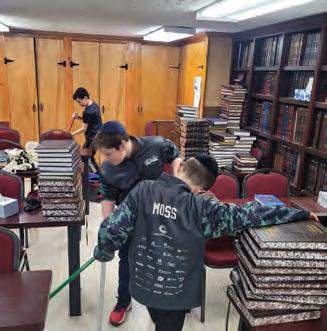













Baltimore Jewish Home (BJH): Can you tell us about your background and roots in Baltimore?
Dr. Elie Miller: I grew up in Boston, but my family has deep roots here in Baltimore. My mother’s family is from Baltimore, and though I wasn’t born here, I have been fortunate enough to settle right in. It’s a homecoming of sorts; my children are the seventh generation of our family to live in Baltimore, which is something I truly value.
BJH: What sparked your interest in medicine?
atricians, and my grandfather, Dr. Bulmash, studied both dentistry and medicine. But we also have many lawyers in the family! My winding path into medicine was my own.
BJH: How did you end up settling in Baltimore?
DEM: After yeshiva, I enrolled in a pre-med post-baccalaureate program at Towson University while continuing my learning at Ner Yisroel Rabbinical College. It was supposed to be temporary, but Baltimore quickly became home.
BJH: Can you walk us through your medical education journey?
BJH: How did Apex Concierge Health come about?
DEM: After working at GBMC for four years, I saw the need for a different healthcare model in the Greater Pikesville area. I wanted to create a practice that served both the Orthodox and broader community with accessible and personalized care.
BJH: What does “concierge” medicine mean in your practice?
DEM: Many assume it means expensive or exclusive care, but that’s not the case. Concierge medicine is about accessibility. My patients get direct access, extended visits, and comprehensive care. My patient base includes professionals, teachers, students, and local healthcare workers. It’s about quality, not exclusivity.
BJH: How is your approach different from traditional healthcare?


DEM: My journey began in yeshiva in Jerusalem, where I volunteered with Magen David Adom, the State of Israel’s ambulance and emergency medical service. While working as an EMT, I quickly developed a passion for medicine. That hands-on experience inspired me to pursue it as a career.
BJH: Does medicine run in your family?
DEM: Somewhat. I have an uncle and a brother-in-law who are accomplished pedi-
DEM: I completed pre-med studies at Towson, then spent a gap year in a research position at Johns Hopkins in the Department of Interventional Radiology. From there, I attended the University of Maryland School of Medicine. My entire medical training- PreMed, research, medical school, and residency were all in greater Baltimore, which gave me deep insight into the city and community’s healthcare resources. I remain deeply invested in local education by teaching students at both Johns Hopkins and the University of Maryland Schools of Medicine.
BJH: What was your research focus?
DEM: Pediatric orthopedic surgery and cancer therapeutics. Research was a big part of our medical school training, and later during residency, I was honored to receive the Resident Researcher of the Year Award. While my primary focus is not research now, it helps me stay current and mentor the medical students that I teach.
DEM: Modern healthcare can be frustrating with long wait times, short visits, and lack of continuity. My practice removes those barriers, focusing on communication and holistic care. We address mental health concerns such as anxiety, depression, and ADHD alongside physical health, knowing that they’re deeply connected.
BJH: What key health advice would you give to the community?
DEM: Don’t wait for a crisis to see a doctor. Preventive care is crucial. Having someone who you can call for same-day care is essential. We only get one body, so find a doctor who understands your needs
and supports your long-term health goals.
BJH: What do you love most about Baltimore?
DEM: The warmth of the community. Since the day I arrived, people welcomed me with open arms- inviting me for Shabbos and offering support. Now, with five kids in local schools and involvement in organizations like Bikur Cholim, I get to see firsthand how Baltimore always steps up for its community.
BJH: Any final thoughts on healthcare’s future?
DEM: Healthcare is evolving, and we need more personal, accessible models. My practice is part of that solution, creating strong doctor-patient partnerships to ensure better care for everyone.
About Dr. Elie Miller
Dr. Elie Miller is a board-certified family medicine physician, adjunct faculty at Johns Hopkins University and University of Maryland School of Medicine, and is the founder of Apex Concierge Health in Pikesville. With roots in Boston and a strong connection to Baltimore, he brings a unique perspective to community healthcare. Trained at the University of Maryland and still on staff at GBMC, DEM is committed to providing personalized, comprehensive medical care that prioritizes both physical and mental well-being.
Contact Information: Apex Concierge Health Website: apexchm.com | Phone: 443.242.726
At the request of the United States, India has detained Aleksej Besciokov, a Lithuanian man suspected of illegally running Garantex, a $96 billion cryptocurrency exchange that permitted terror groups, drug traffickers, and cybercriminals to launder money.
The U.S. had been pursuing the arrest of Besciokov, a resident of Russia who was in the Indian state of Kerala on vacation with his family at the time of his detainment. He awaits extradition to the U.S. Eastern District of Virginia.
Just a week before his arrest, the U.S.
Department of Justice indicted Besciokov, who they said was responsible for keeping Garantex up and running, and an accomplice named Aleksandr Mira Serda, a Russian who served as the exchange’s co-founder and “chief commercial officer.”
Besciokov and Mira Serda are each charged with one count of conspiracy to commit money laundering, which carries a maximum sentence of 20 years in prison. Besciokov is also charged with one count of conspiracy to violate the International Economic Emergency Powers Act— which also carries a maximum sentence of 20 years in person—and with conspiracy to operate an unlicensed money transmitting business, which carries a maximum sentence of five years in prison.
In 2022, the U.S. Treasury Department attempted to crack down on Garantex through sanctions. However, that didn’t work, as the company’s operations were reworked to dodge sanctions and trick U.S. businesses into collaborating with Garantex. Now, the U.S. is trying to stop money launderers by arresting them.
Launched in 2019, Garantex was first sanctioned by the U.S. Treasury Office
of Foreign Assets Control in April 2022 for receiving hundreds of millions in criminal proceeds, including funds used to facilitate hacking, ransomware, terrorism and drug trafficking. Since those penalties were levied, Garantex has processed more than $60 billion.

Mikheil Saakashvili, a former president of Georgia who served over two terms from 2004 to 2013, was sentenced on Monday to four-and-a-half more years in jail. His latest sentence, which he has declared “illegal and “unjust,” brings his total up to over 12 years in prison.
Saakashvili was sentenced for illegal-
ly crossing into Georgia in 2021, during which he was in exile. According to rights groups, including the Council of Europe, he was jailed for political reasons. Saakashvili, who tried to strengthen the country’s relationship with Western nations, is against Georgian Dream, the pro-Russian party that rules Georgia.
Last week, Saakashvili, 57, was also sentenced to nine years in prison for embezzlement. He was initially tried and sentenced twice in 2018.
After leaving Georgia following his presidency, Saakashvili mostly lived in Ukraine, which gave him citizenship in 2015 when he became the governor of Odesa, Ukraine. At the same time, he renounced his Georgian citizenship. In 2017, his Ukrainian citizenship was revoked, but it was reinstated in 2019 by Ukrainian President Volodymyr Zelensky, who appointed the former Georgian president to oversee reforms in Ukraine.
“This [sentence] is basically sending a message... to President Zelensky, for them to scare him to show what happens when you don’t surrender your country... I did not surrender Georgia,” said Saakashvili in a video, adding: “No mat-
6:15 am Young Israel Shomrai Emunah M-F
6:25 am Southeast Hebrew Cong., Knesset Yehoshua M-F
6:30 am Beth Sholom Congregation M-F
Beit Halevi (Sfardi) M, T Chabad of Silver Spring M-F
Ohev Shalom Talmud Torah OLNEY M-F
Young Israel Shomrai Emunah S YGW M, Th
6:35 am Ohr Hatorah M, Th
6:40 am YGW S, T, W, F
Magen David Sephardic Congregation M-Th
6:45 am Beit Halevi (Sfardi) S, T, W, F
Kemp Mill Synagogue M, Th
Ohr Hatorah T, W, F
Young Israel Shomrai Emunah M, Th
6:50 am Woodside Synagogue/Ahavas Torah M, Th Silver Spring Jewish Center M-F
Chabad of Upper Montgomery County M-F
6:55 am Young Israel Shomrai Emunah T, W, F
7:00 am Kemp Mill Synagogue T, W, F
Southeast Hebrew Cong., Knesset Yehoshua S Silver Spring Jewish Center S
BETHESDA
Magen David Sephardic Congregation [S] 11215 Woodglen Dr, North Bethesda, MD 20852
GAITHERSBURG
Chabad of Upper Montgomery County [Ari] 11520 Darnestown Rd, Gaithersburg, MD 20878
OLNEY Ohev Shalom Talmud Torah (OSTT)
18320 Georgia Ave, Olney, MD 20832
Woodside Synagogue/Ahavas Torah T, W, F
Young Israel Ezras Israel of Potomac T, W, F
7:05 am Kesher Israel M, Th
7:15 am Kemp Mill Synagogue M, Th Kesher Israel T, W, F
Ohev Sholom Talmud Torah/The National Synagogue M-F
Ohr Hatorah S
7:30 am Chabad of DC M-F
Chabad of Potomac M-F JROC M-F
Kemp Mill Synagogue T, W, F
Southeast Hebrew Cong., Knesset Yehoshua M-F
Young Israel Shomrai Emunah S
Young Israel Shomrai Emunah (Sfardi) M-F
7:45 am YGW (Yeshiva Session Only) S-F
8:00 am Beth Sholom Congregation S
Kemp Mill Synagogue S Kesher Israel S
Ohev Shalom Talmud Torah OLNEY S
Southeast Hebrew Cong., Knesset Yehoshua S
Chabad of Upper Montgomery County S Woodside Synagogue/Ahavas Torah S
Beth Sholom Congregation 11825 Seven Locks Rd. Potomac, MD 20854 Chabad of Potomac [Ari]
8:00 am YGW (High School; School-Contingent) S-F
Young Israel Ezras Israel of Potomac S Young Israel Shomrai Emunah (Sfardi) S
8:05 am Ezras Israel Congregation of Rockville M, Th
8:15 am Ohr Hatorah S Ezras Israel Congregation of Rockville S, T, W, F
Kehilat Pardes / Berman Hebrew Academy S-F
Silver Spring Jewish Center M-F
8:30 am Chabad of DC S Chabad of Potomac S JROC S Ohev Sholom Talmud Torah/The National Synagogue S
Silver Spring Jewish Center S YGW (Summer Only) S-F
8:45 am Young Israel Shomrai Emunah S-F
9:00 am Chabad of Silver Spring S Kemp Mill Synagogue S
mincha
2:15 pm Silver Spring Jewish Center S-F
2:20 pm YGW M, T, W
2:45 pm YGW M-Th
3:00 pm YGW Middle School School Days
Before Shkiah (15-18 minutes), S-TH
Beit Halevi (Sfardi)
Beth Sholom Congregation
Chabad of Potomac
Chabad of Silver Spring
Chabad of Upper Montgomery County
Ezras Israel Congregation of Rockville (20 min before, S-F) JROC
Kemp Mill Synagogue
Kesher Israel
Magen David Sephardic Congregation
Ohev Sholom Talmud Torah/The National Synagogue Ohr Hatorah
Silver Spring Jewish Center
Southeast Hebrew Congregation Woodside Synagogue/Ahavas Torah
Young Israel Ezras Israel of Potomac
Young Israel Shomrai Emunah (Asheknaz) Young Israel Shomrai Emunah (Sefarhadi) maariv
8:15 pm OSTT (OLNEY) S-Th
8:45 pm YGW School Days
9:30 pm YGW S-Th Silver Spring Jewish CenterSpring/Summer
9:45 pm Ohr Hatorah M-Th
10:00 pm YGW S-Th
W E D D I N G P A C K A G E

ter what, I will fight to the end.”
Zelensky and the European Union have called for Saakashvili’s release.
Georgia, formerly of the Soviet Union, is bordered by Russia, Turkey, Armenia and Azerbaijan. The majority of its population lives in Tbilsi, the capital.

Early this month, armed forces affiliated with the new government of Syria entered the Syrian village of al-Sanobar, or “Pine Village,” and executed many members of the minority Alawite sect.
One video posted by a fighter shows him marching around a ransacked house where two males were killed, singing the words, “Ethnic cleansing, ethnic cleansing.” More footage showed him singing, “We’ve come to you. We’ve come to you with the taste of death,” while standing in front of several bodies.
A few thousand people live in the village. Thus far, reports have confirmed the killings of 84 people, while residents claim that more than 200, mostly men, were killed by the forces. The fighters killed individuals who were unarmed and not allied with the former government of Bashar al-Assad.
Interim President Ahmad al-Sharaa has disavowed any connection with the forces responsible for the killings and has said he started a committee to investigate the executions in an effort to hold the ag-
gressors responsible.
The Assad family is part of the Alawite sect, which is a minority offshoot of Shia Islam.
On March 6, Assad loyalists ambushed Sharaa’s Syrian forces, leading to the deadliest battle since Assad’s fall at the end of last year. Since then, attacks have killed over 800 people, according to the Syrian Network for Human Rights. The attacks on Pine Village started a day after the ambush. Three days later, armed forces organized the retrieval of all the bodies that lay on the village streets.

John “Paddy” Hemingway died this week at the age of 105. He was the last surviving pilot of the Battle of Britain.
Hemingway was an Irish national who enlisted in the Royal Air Force in 1938, before the war began. He was just 20 years old when he and his comrades in the Royal Air Force took to the skies to fight off wave after wave of Nazi aircraft that sought to pound Britain into submission during the summer and autumn of 1940.
German bombers had been relentlessly targeting airfields in southern England. At the time, Prime Minister Winston Churchill famously stood before the House of Commons to pay tribute to the young pilots who were defending Britain.
“The gratitude of every home in our island, in our empire, and indeed

throughout the world, except in the abodes of the guilty, goes out to the British airmen who, undaunted by odds, unwearied in their constant challenge and mortal danger, are turning the tide of the world war by their prowess and by their devotion,” Churchill said. “Never in the field of human conflict was so much owed by so many to so few.”
Britain has ever since revered “the few” for saving the country during its moment of peril. The Battle of Britain Memorial on the English Channel coast lists the names 2,941 Allied airmen who took part in the battle.
During dogfights with German aircraft in August of 1940, Hemingway was twice forced to bail out of his Hurricane fighter, once landing in the sea off the east coast of England before returning to his squadron to resume the fight, the RAF said. He was awarded the Distinguished Flying Cross for gallantry in 1941.
Hemingway would dismiss notions of his heroism.
“The world was at war, and you couldn’t go somewhere and say, ‘I’m at peace and I don’t fight wars,’” he said in a 2020 interview with the BBC. “The main skill was luck. You had to be lucky, no matter how good you were. For instance, my boss, Dickie Lee, was the best pilot I’ve every seen, but he was shot down and killed. So he had no luck. I had bags of luck.”
At the end of the war, Hemingway served as commander of No. 43 Squadron, which flew Spitfires in northern Italy. He remained in the RAF after the war and retired in 1969 after more than 30 years of service.
For two days, Lebanese and Syrian forces clashed along the border. At least seven Lebanese citizens were killed and 52 others were injured. Five Syrian soldiers were killed. On Monday, a ceasefire halted the fighting.
The agreement stipulated “enhanced coordination and cooperation between the two sides,” the statement from the Syrian Ministry of Defense said.
Syria’s interim government accused terrorists from Lebanon’s Hezbollah of crossing into Syria on Saturday, abducting three soldiers and killing them on Lebanese soil. Hezbollah denied involvement; some other reports pointed to local clans in the border region that are not di-
rectly affiliated with Hezbollah but have been involved in cross-border smuggling. It was the most serious cross-border fighting since the ouster of former Syrian president Bashar Assad in December.

Syrian News Channel, citing an unnamed Defense Ministry official, said the Syrian army shelled “Hezbollah gatherings that killed Syrian soldiers” along the border. Hezbollah denied involvement in a statement on Sunday.
The Lebanese and Syrian armies said they have opened channels of communication to ease tensions. Lebanon’s military also said it returned the bodies of the three killed Syrians. Large numbers of Lebanese troops have been deployed in the area.
Lebanon has been seeking international support to boost funding for its military as it gradually deploys troops along its porous northern and eastern borders with Syria as well as its southern border with Israel.

El Al’s annual net profit grew to about $545 million in 2024, a record-breaking number, far surpassing previous years’ bonanzas. Many foreign carriers suspended their Israel routes due to the wars that Israel has been fighting on many fronts.
The airline’s previous record high of $116 million was in 2023, driven by a fourth quarter that saw competition melt away after the October 7 massacre





and the subsequent war in Gaza. In the fourth quarter of 2024, El Al made a net profit of $130 million, compared with the $40 million in the fourth quarter of 2023.
El Al’s revenue in 2024 was $3.4 billion, up some 37% from $2.5 billion in 2023, the company’s previous all-time high. The airline’s gains enabled it to reduce its net financial debt — total liabilities minus cash and liquid assets — from $1.6 billion at the end of 2023 to $75 million at the end of 2024.
According to El Al, the carrier controlled 97.5 percent of the market share on flights to North America, with flights, on average, 96 percent full.
El Al’s CEO Dina Ben Tal Ganancia said in a statement that ticket prices rose “just 14%” on average per passenger in 2024.
The year “confronted us with complex national and business challenges, but we’ve proven our ability to handle them successfully,” she said. “Despite the challenges, we were able to maintain an aerial bridge between Israel and the world.”
Small airlines like Israir and Arkia are preparing to launch their own North American routes. United Airlines resumed flight services to Israel this week, and Delta Air Lines is scheduled to restart its Tel Aviv-New York route on April 1.

In an interview aired Saturday with Fox News, Tal Shoham, a former hostage who was released from Gaza on February 22, spoke about his 505 days in Hamas captivity.
On October 7, when Hamas and Gazan civilians invaded southern Israel, terrorists stormed into Shoham’s in-laws’ house in Kibbutz Be’eri, where he, his wife Adi, and their two children, Yahel and Naveh, who were at the time three and eight respectively, were staying. Shoham confronted the assailants in an effort to save his wife and children but was met by “about 40 armed terrorists,” who were videoing and laughing at him.
He was then separated from his family, driven to Gaza in the trunk of a car, and forced out. Hamas demanded that he bow to them, but he said no.
“I said, ‘I can’t control whether you kill me or not,’ and I raised my hands — but I refused to kneel,’” Shoham said. “If you want to kill me, kill me, but you will not execute me like ISIS.”
The terrorists then marched Shoham through Gaza, where he was met by jeers from crowds of Palestinians. “I just waved and smiled,” Shoham said. “I didn’t show fear.”
For the first 50 days in Gaza, Shoham didn’t know whether his wife and children were alive. Thus, to cope with the unspeakable uncertainty, he had to “accept that my family was dead.”
“I sat on the floor and imagined myself at their funeral. I stood in front of a grave — one large for my wife, and two small for my children — and I eulogized each of them,” he explained. “I sobbed but didn’t let my captors see me cry. That was the hardest thing I’ve ever done, burying my family in my mind.”
On day 50, he got a letter from his wife telling him that she and the children had been released in the short-lived ceasefire in November 2023.
For 34 days, Shoham was held alone, after which he was put together with Evyatar David and Guy Gilboa Dalal. In June 2024, the three were brought to an underground tunnel, where Shoham stayed until being freed, and were held alongside Omer Wenkert.
According to Shoham, Hamas, even through the war, “never stopped digging tunnels. Not for a single day.”
Shoham emerged from captivity emaciated. He estimates that he consumed only 300 calories a day. For the first three days, he ate pita bread. Then, “food supplies dwindled.” He was then given tiny portions, as small as “three spoons of avocado and three dates” a day, “or half an orange from a tree in the yard.” In the tunnel, he would get plain rice and around 300 milliliters of water a day to drink and wash himself with. He was extremely malnourished.
At one point, he had a serious infection and internal bleeding in his legs, which forced Hamas to bring him to a doctor. The doctor provided him with blood thinners and vitamin supplements, which helped.
Wenkert was released alongside Shoham. David and Gilboa Dalal remain in captivity.
On October 7, Hamas kidnapped 251


people. Now, 58 remain in captivity, at least 35 of whom have perished in Gaza.
After coming at odds with Israel, Adam Boehler, the Trump administration’s candidate for special presidential envoy for hostage affairs, has dropped his candidacy. He will remain in the administration as a lower-level appointee to help release American prisoners and hostages around the world.
Recently, Boehler negotiated directly with Hamas, an unprecedented move meant to convince the terror group to release Hamas’ last living American hostage, Edan Alexander, a U.S.-Israeli citizen held in Gaza, as well as the bodies of four deceased American hostages.
Israel was not informed ahead of time about Boehler’s direct talks with Hamas. The negotiations upset the Jewish state, which leaked information about the talks to the press on March 4. A few weeks ago, before the talks were revealed, Boehler started getting ready to withdraw his candidacy.
On Sunday, Boehler tried in interviews to ease Israeli concerns but instead made the situation worse.
He explained, “The most productive [approach] is to realize that every piece of a person is a human and to identify with the human elements of those people and then build from there.” Boehler also called the hostages held in Gaza “prisoners” and branded Palestinian criminals detained in Israel as “hostages.”
He added that he understands the concerns of Strategic Affairs Minister Ron Dermer, who has criticized Boehler, but noted: “I don’t really care about that that much — no offense to Dermer.”
“We’re the United States. We’re not an agent of Israel,” Boehler said.
Last week, Hamas said it would release Alexander. Two days later, the terror group reneged on its promise after outlining a list of outrageous conditions for his release.
Prime Minister Benjamin Netanyahu recently announced his intention to fire
Ronen Bar, the director of the Shin Bet. The cabinet was expected to vote to oust Bar on Wednesday.
Netanyahu notified Bar of the decision recently in what Channel 14 described as “not an easy conversation.”
Netanyahu is, according to some, attempting to place blame for the October 7 massacre on Israel’s security agencies, including the Shin Bet, as opposed to other entities in government, including political and legislative ones. Bar has previously said he would eventually step down from his position due to his agency’s failure to stop Hamas’ attacks. However, Bar has resisted calls for his immediate ouster, as he reportedly believes that Netanyahu will just replace him with a loyalist. Instead, he purportedly hopes to resign after all hostages are released and a state commission of inquiry on the October 7 massacre is established.
“At all times, but especially during an existential war such as we face, there must be full trust between the prime minister and the head of the Shin Bet,” said Netanyahu in a statement early this week. “But unfortunately, the situation is the opposite — I do not have such trust. I have ongoing distrust in the head of the Shin Bet, a distrust that has only grown over time.”
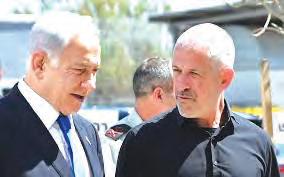
The premier added that he appreciates “the men and women of the Shin Bet” and that he believes “this step is critical for the rehabilitation of the organization, for achieving all our war aims, and for preventing the next disaster.”
According to the Attorney General’s Office, Netanyahu must speak with the attorney general’s office first before firing Bar, though the prime minister seems to have ignored that order.
At the Shin Bet, there is an ongoing investigation into Netanyahu’s top aides’ ties to Qatar.
As ceasefire talks between Israel and Hamas collapsed this week, the IDF
launched dozens of strikes throughout Gaza early Tuesday morning.
At least 404 Palestinians were killed in the strikes, according to unverified figures from the Hamas-run health ministry, which doesn’t differentiate between civilians and combatants. It said another 562 were wounded.
Netanyahu’s office said the decision to resume strikes shortly after midnight “followed Hamas’s repeated refusal to release our hostages, as well as its rejection of all of the proposals it has received from U.S. special envoy to the Mideast Envoy Steve Witkoff and from the mediators.”
Hamas has insisted on sticking to the original terms of the deal, which was supposed to enter its second phase at the beginning of the month. That phase envisioned Israel fully withdrawing from Gaza and agreeing to permanently end the war in exchange for the release of the remaining living hostages. But Netanyahu has long said that the war will only be over when Hamas and its government will be completely destroyed.
Witkoff has proposed extending phase one of the ceasefire for several weeks in exchange for the release of five living hostages. On Sunday, Witkoff said that Hamas’s response to the offer was a “nonstarter” and warned of impending consequences if the terror group did not change its approach.
White House press secretary Karoline Leavitt told Fox News that Israel had consulted with the Trump administration before conducting the strikes.
“As President Trump has made it clear: Hamas, the Houthis, Iran — all those who seek to terrorize, not just Israel, but the United States of America — will see a price to pay. All [heck] will break loose,” she said.
“Hamas could have released hostages to extend the ceasefire but instead chose refusal and war,” White House National Security Council spokesperson Brian Hughes separately said.
On Tuesday, Hamas said in a statement that Netanyahu’s government’s decision to “overturn the ceasefire agreement” exposes the hostages “to an unknown fate.”
The terror group called on the mediators — the U.S., Qatar and Egypt — to hold Netanyahu fully responsible for breaking the ceasefire.
It also demanded Arab and Muslim countries to back “Palestinian resistance” aimed at “breaking the unjust blockade imposed on Gaza.” Hamas also urged the UN Security Council to ur-
gently convene to issue a resolution obligating Israel to halt its “aggression.”

But Netanyahu’s government showed determination against the terror group, stating in a statement that, moving forward, Israel will “act against Hamas with increasing military strength,” adding that the operation is designed to achieve Israel’s war aims: the dismantlement of Hamas’ military and governing capabilities and the return of all remaining 59 hostages.
The issue of ending the ceasefire is a heartbreaking conundrum in Israel. On the one hand, most people understand that Hamas needs to be destroyed. At the same time, there are Israelis still being held in Gaza, their lives at risk every day until we can bring them back home.
Hostage Omri Miran’s wife Lishay tweeted a broken heart emoji shortly after the strikes began. Former hostage Noa Argamani posted the same thing.
Many members of Hamas were killed in the strikes this week, among them: Issam Da’alis, a member of Hamas’s political bureau in Gaza and head of the governmental activity monitoring committee, a position roughly akin to prime minister; Ahmad al-Khatta, the director-general of Hamas’s justice ministry; Mahmoud Abu Watfa, who headed the terror group’s interior ministry, responsible for Hamas’s police and internal security services in Gaza; and Bahjat Abu Sultan, head of Hamas’s internal security forces, which is under the interior ministry.
Abu Ubaida Al-Jamassi, also a member of Hamas’s political bureau in Gaza and, according to some sources, the head of Hamas’s emergency committee — which has managed Gaza during the war — was also killed overnight.
This week, Google’s parent company Alphabet agreed to buy Israeli-founded cybersecurity unicorn Wiz in a cash deal for a jaw-dropping record $32 billion. The deal, the largest-ever purchase of an Israeli tech company, was hailed in

Israel as a sign of the country’s technological prowess and resilience during the war period.
It marks the largest deal in Israeli tech after U.S. giant Intel Corp bought Mobileye, a Jerusalem-based developer of advanced vision and driver assistance systems, for $15.3 billion in 2017.

For Google, it is the largest acquisition the search giant has ever made, almost triple its record purchase of Motorola Mobility for $12.5 billion in 2012. As part of the deal, Wiz will join Google’s Cloud division.
“From its earliest days, Google’s strong security focus has made us a leader in keeping people safe online,” said Google CEO Sundar Pichai, announcing the agreement. “Today, businesses and
governments that run in the cloud are looking for even stronger security solutions and greater choice in cloud computing providers.
“Together, Google Cloud and Wiz will turbocharge improved cloud security and the ability to use multiple clouds,” Pichai added.
Alphabet had offered to buy Wiz in July for $23 billion but the Israeli company walked away from that deal partly due to concerns over the clearance of antitrust hurdles by regulatory bodies. At the time, Wiz co-founder Assaf Rappaport said that Wiz sought to remain an independent cybersecurity unicorn rather than being absorbed by the tech giant. The company set out a growth path to double its annual recurring revenue (ARR) to $1 billion by 2025 and was eyeing plans for an initial public offering (IPO).
In May, Wiz, which says that its cyber platform is tailored to secure everything developers build and run in the cloud, was valued at $12 billion after closing its last funding round of $1 billion.
The cybersecurity unicorn was established in early 2020 just as the pandemic started gaining strength around
the world, sending entire enterprises and workers online and spurring a huge migration wave to cloud-based servers.
Wiz was co-founded by Rappaport, Yinon Costica, Ami Luttwak and Roy Reznik, the same team that founded the firm Adallom, which was sold to Microsoft for $320 million in 2015. They also led Microsoft Azure’s Cloud Security Group. Its customers include 40 percent of the Fortune 100 companies, such as Slack, Mars, BMW, DocuSign, Plaid and Agoda.
On Friday, a jury in Los Angeles awarded a man $50 million in his case against Starbucks after he suffered burns when a hot cup of tea spilled onto his lap in 2020.
Michael Garcia had been waiting at a
drive-thru window where he was awaiting a delivery for a food order on February 8, 2020. One of the drinks on the tray he was handed overturned, severely scalding him.
Court records show Garcia had ordered three venti-sized “medicine ball” hot teas and was picking them up at the drive-thru when the lawsuit alleges the barista “negligently” failed to properly secure one of the drinks into the to-go carrier. The unsecured cup fell directly into Garcia’s lap within 1.4 seconds of him taking possession of the tray, with the lid popping off and hot tea leaving him with third-degree burns.
“Starbucks says if our hands are off the drink, then no matter what happens, we’re not responsible,” said Garcia’s trial attorney Nicholas Rowley. “So, if I’m Starbucks and I hand you a drink that doesn’t have a lid that’s secured, and it’s a scalding hot, 180-degree drink, or if I hand you a drink that’s in a container and it’s loose and it’s not secured, and it falls right on you — the moment that I take my hands off of it, then you’re responsible and I, the corporation, am not.”
After the verdict, Rowley said, “Mi-














chael Garcia’s life has been forever changed. No amount of money can undo the permanent catastrophic harm he has suffered, but this jury verdict is a critical step in holding Starbucks accountable for flagrant disregard for customer safety and failure to accept responsibility.”
A Starbucks spokesperson said, “We sympathize with Mr. Garcia, but we disagree with the jury’s decision that we were at fault for this incident and believe the damages awarded to be excessive,” the statement said. “We plan to appeal. We have always been committed to the highest safety standards in our stores, including the handling of hot drinks.”
Garcia began receiving treatment at the Grossman Burn Center in L.A. six days after the incident.
Starbucks had initially offered $3 million to Garcia pre-trial, later upping that amount to $30 million to settle. Garcia agreed, but under the condition that they apologize, change their policies, and issue a memo to all store locations to double-check their hot drinks before handing them to customers, attorneys said.
When the coffee chain declined to agree to those terms, the jury eventually decided to award Garcia with Friday’s total.

Rep. Nita Lowey, the former congresswoman who served suburban parts of New York City, including Westchester County and the Hudson River Valley, died last week at the age of 87. She was the first woman to chair the powerful House Appropriations Committee.
New York Gov. Kathy Hochul, a fellow Democrat who served with Lowey in Congress, ordered flags flown at halfstaff Sunday through Monday in honor of her former colleague.
“A public servant in the truest sense, she was guided by the Jewish core value of ‘Tikkun Olam,’ repairing the world,” Lowey’s family’s statement read. “She was an indefatigable fighter and worked across the aisle to deliver results for her constituents and all Americans.”
Lowey was first elected to Congress
in 1988 and served until she opted to retire rather than seek reelection in 2020.
“Frankly to have a job that I love so very much made this a very difficult choice,” Lowey, who became chair of the House Appropriations Committee in 2018, told The Associated Press of her decision to retire. “But I just felt it was time.”
U.S. Rep. Mike Lawler, a Republican who now represents Lowey’s congressional district, praised her “bipartisan spirit, commitment to our community, and dedication to the country.”

President Donald Trump on Saturday ordered “decisive” military action against the Houthis, a U.S.-designated terror group that has been wreaking havoc on the Red Sea since the war in Gaza started.
According to the Houthi-controlled health ministry, 53 or more individuals were killed and nearly 100 others were injured in Yemen after the United States launched strikes at the terror group. The strikes reportedly caused a power outage in the city of Dahyan and hit Houthi military sites in Taiz.
The strikes, according to national security adviser Michael Waltz, killed “multiple” Houthi leaders and were aimed at “holding Iran responsible” for the Houthis, an Iranian proxy group.
In response to “American aggression,” the Houthis said they launched 18 drones and missiles at the U.S.’s USS Harry Truman, an aircraft carrier in the northern Red Sea. Abdul Malik alHouthi, the terror group’s leader, threatened in a statement to escalate the conflict if the “aggression” continues. The Truman wasn’t damaged, and those on board were not injured, two U.S. officials confirmed.
The Houthis have been attacking Red Sea vessels since late 2023 in solidarity with Hamas, another Iranian proxy group that murdered 1,200 people and took captive 251 others from Israel on October 7, triggering an all-out war. The Houthis stopped attacking in January, after a ceasefire started in Gaza. Howev-
er, now that the ceasefire has ended, the Houthis have vowed to continue assaulting local ships.
Trump, in a social media statement, said the Houthis were behind an “unrelenting campaign of piracy, violence, and terrorism against American, and other, ships, aircraft, and drones.” He added that the U.S. would continue conducting aerial assaults on Houthi bases, leaders, and missile defenses “to protect American shipping, air, and naval assets, and to restore Navigational Freedom.”
“No terrorist force will stop American commercial and naval vessels from freely sailing the Waterways of the World,” Trump added.
The president said that Iran must “immediately” stop supporting the Houthis and warned that “America will hold [Tehran] fully accountable” if the U.S. is threatened by Iran.
“The United States Government has no authority, or business, dictating Iranian foreign policy,” Iranian Foreign Minister Seyed Abbas Araghchi responded. “End support for Israeli genocide and terrorism. Stop killing of Yemeni people.”
In a conversation with Russian official Sergei Lavrov, Secretary of State Marco Rubio spoke about the strikes. In the summer of 2024, Moscow considered providing weapons to the Houthis but decided not to after pushback from the U.S. and Saudi Arabia. Lavrov “emphasized the need for an immediate cessation of the use of force” in Yemen.
In January, Trump signed an executive order declaring the Houthis a “foreign terrorist organization.” The president called the tactics of his predecessor, Joe Biden, “pathetically weak, so the unrestrained Houthis just kept going.”

On Friday, a dust storm in Sherman County, Kansas, killed eight people and hit over 50 vehicles. Tornadoes also ripped through Mississippi, killing six people and injuring 29 others, and Missouri, where at least 12 people died. In Arkansas’ Independence County, storms
killed three people and injured 29 others. Also on Friday, a dust storm in Amarillo, in the Texas Panhandle, killed three others. In all, this storm outbreak has killed 32 people thus far.
Arkansas Gov. Sarah Huckabee Sanders, Mississippi Gov. Tate Reeves, and Georgia Gov. Brian Kemp declared states of emergency.
The major storm system brought about high winds and deadly dust storms and started 100 wildfires. According to forecasts, eighty-mile-per-hour winds were expected to hit everywhere from Texas to the Canadian border, an area where over 100 million people live. The high wind speeds prompted the National Weather Service on early Saturday to issue blizzard warnings for parts of far western Minnesota and far eastern South Dakota, where 3 to 6 inches were predicted, and up to a foot of snow possible.
Oklahoma, where almost 300 homes were destroyed or damaged, had been grappling with over 130 wildfires. According to Gov. Kevin Stitt, the fires burned around 266 square miles.
Major tornadoes on Saturday continued traveling through the U.S., threatening the area from eastern Louisiana and Mississippi to Alabama, western Georgia, and the Florida panhandle, according to the Storm Prediction Center.

Their trip was supposed to take eight days. Instead, they were stuck in space for 286 days at the International Space Station. This week, Barry “Butch” Wilmore and Sunita Williams undocked from the space station for their long-awaited return to Earth.
Launched last June aboard Boeing’s problem-plagued Starliner capsule, Wilmore and Williams are sharing the 17hour ride home with Crew 9 commander Nick Hague and cosmonaut Alexander Gorbunov, who were launched to the station last September aboard the same SpaceX Crew Dragon capsule carrying all four of them home.


“On behalf of Crew 9, I’d like to say it was a privilege to call the station home, to live and work and be a part of a mission and a team that spans the globe, working together in cooperation for the benefit of humanity,” Hague radioed as the Crew Dragon drifted away from the station.
“To our colleagues and dear friends who remain on the station ... we know the station’s in great hands. We’re excited to see what you guys are going to accomplish.”
The four are expected to splashdown off Florida’s Gulf Coast at around 6 p.m. on Tuesday evening. A SpaceX recovery ship will be stationed nearby to haul the spacecraft on board so the crew can be helped out of the Crew Dragon’s cabin and onto stretchers for initial medical checks.
For Wilmore and Williams, the long overdue trip back to Earth will wrap up a repeatedly extended mission totaling 286 days and 7 hours and spanning 4,576 orbits and 121 million miles. They originally expected to spend just eight days or so in orbit.
Wilmore and Williams launched to
ple propulsion system helium leaks and thruster problems during rendezvous with the space station, and NASA eventually decided to keep them on the station and to bring the Starliner down, without its crew, by remote control.
NASA launched the next crew rotation mission — Crew 9 — in September carrying just two crew members, Hague and Gorbunov, instead of four. Wilmore and Williams then joined the Crew 9 fliers aboard the ISS for a normal-duration six-month mission.
NASA cleared the way for Crew 9’s return to Earth by launching four replacements — Crew 10 commander Anne McClain, pilot Nichole Ayers, cosmonaut Kirill Peskov and Japanese astronaut Takuya Onishi — last Friday.
Normal practice calls for a five-day “handover” between crews so the new arrivals can be fully briefed on the ins and outs of station operations and maintenance. But in this case, handover was shortened to just one day to take advantage of predicted favorable splashdown
muscle loss in the weightlessness of space. Even so, Wilmore and Williams will face extensive rehabilitation over the next several weeks and months as their bodies readapt to the unfamiliar tug of gravity.
Hague and Gorbunov, who spent spent 171 days in space, will re-adapt more quickly, perhaps, but both will require physical therapy.
While 286 days is a long flight by normal NASA standards, it’s well short of the U.S. record for a single flight — 371 days, set by astronaut Frank Rubio in 2022-23. Rubio’s record also resulted from a system issue, when a coolant leak was discovered in the Russian Soyuz.
Given Williams’ two previous stays aboard the space station, she will move up to No. 2 on the list of most experienced U.S. astronauts with 608 days in space overall. Only former astronaut Peggy Whitson has more time aloft, 675 days over four flights. Wilmore’s total across three flights will stand at 464 days aloft.


Dr. Rasha Alawieh, a doctor at Brown Medicine in Rhode Island, had a “valid” H-1B visa but was deported over the weekend after it was discovered that she held pro-Hezbollah beliefs and had attended the funeral of Hezbollah leader Hassan Nasrallah.
President Donald Trump made immigration a core component of his campaign victory and has pledged to deport millions of migrants without legal status. On Friday, a court ordered Alawieh’s removal from the country. She was detained at Boston Logan International Airport on Thursday after returning from a two-week visit to Lebanon with her family.
The Department of Homeland Security (DHS) said on Monday that Alawieh told customs agents during her detainment that she had traveled to Beirut to







attend the funeral of Hassan Nasrallah, the leader of the Iran-backed group Hezbollah.
“Last month, Rasha Alawieh traveled to Beirut, Lebanon, to attend the funeral of Hassan Nasrallah— a brutal terrorist who led Hezbollah, responsible for killing hundreds of Americans over a four-decade terror spree,” the DHS said in a statement on social media.
“Alawieh openly admitted to this to CBP [U.S. Customs and Border Protection] officers, as well as her support of Nasrallah. A visa is a privilege not a right—glorifying and supporting terrorists who kill Americans is grounds for visa issuance to be denied. This is common sense security,” the statement added.
Federal agents found photos of Hezbollah leader Nasrallah and Iran’s supreme leader on Alawieh’s cellphone.
On Friday, U.S. District Judge Leo Sorokin ordered an in-person hearing to be scheduled for Monday, requiring Alawieh to appear in court. By Saturday, Alawieh’s cousin Yara Chehab had filed a motion accusing customs officials of “willfully” violating the order by deporting her to Lebanon.
In a court filing on Monday, government lawyers argued that CBP officers were unaware of the judge’s order until after Alawieh had “already departed the United States.” They requested that the petition be dismissed.
Alawieh, who earned her medical degree from the American University of Beirut in 2015, had worked at Brown Medicine since July 2024, where she was an assistant professor of medicine in the nephrology department. She had spent the past six years in the U.S., pursuing fellowships.
The Council on American-Islamic Relations (CAIR) said in a statement, “We call on the Trump administration to immediately readmit Dr. Rasha Alawieh, who was wrongly deported despite possessing a valid visa and despite a court order protecting her from deportation.”
The White House posted on X, “Byebye, Rasha.”
Republican Representative Donald McFarlane, a member of the New Hampshire House of Representatives, said on X, “We’ve been hearing outcries that Rasha Alawieh, a Rhode Island Doctor, and assistant professor at Brown University, and who has been here from Lebanon on a work visa...was wrongly deported
by mean, evil customs officials.
“Turns out she was sent back to her native Lebanon because she is a fan of Hamas and Hezbollah, and explicitly admitted as much to immigration officials, after having just returned from attending a terrorist’s funeral. Apparently, she explained that she only supports these terrorists ‘spiritually’ and not politically or militarily.”
This week, PepsiCo announced that it entered into an agreement to purchase Poppi, the prebiotic beverage company, for $1.95 billion. The acquisition will allow PepsiCo to “evolve its portfolio” and expand its “betterfor-you offerings.”
PepsiCo’s purchase will mark the company’s first step into the prebiotic soda industry, which has grown in recent years with the popularity of brands like Olipop, Culture Pop and most recently, Coca-Cola’s Simply Pop.

Poppi, bottled in bright and bold cans, is a soda that contains prebiotics from agave insulin and cassava root fiber; apple cider vinegar; fruit juice; and sugar. It first debuted on “Shark Tank,” when founders Allison and Stephen Ellsworth accepted a $400,000 investment in exchange for 25% of the company from Guest Shark Rohan Oza. Known at the time as Mother Beverage, the soda was rebranded and first found on Whole Foods Market shelves.
“With the help of an investment on Shark Tank, Poppi has gone from farmers’-market-favorite to sitting pretty on the shelves of every major retailer across the nation,” the company’s website says, noting that the sodas are “beloved” by celebrities.
Poppi’s sales topped $100 million by 2024, and those numbers continue to grow as the drink represents 19% of the U.S. market share.
Yehuda Ashkelon has a different idea of fun than most people. During Covid, when most of the world was hibernating at home, Ashkelon decided that memorizing the numbers of the mathematical constant Pi would be fun.
“During the Covid pandemic, I had more time for intellectual challenges, and memorizing Pi became an interesting exercise in cognitive discipline,” Ashkelon said.
The Israeli theoretical physicist recent set a new Israeli record in memorizing the magic number, reciting 25,333 decimal places.
Ashkelon, a Ben-Gurion University PhD student who recited the numbers in Spanish, now holds the world record for Spanish Pi memorization. The entire recitation lasted 6 hours and 28 minutes. The previous record in Spanish was 20,000 decimal places. Ashkelon had been living in Spain when he decided to embark on this feat.
His Pi prowess places him in ninth place worldwide and is the highest recorded in Israel in any language.
The scientist recited the numbers at Ben-Gurion University on March 10, since Pi Day — marked on March 14, whose date can be written as 3.14, the first digits of Pi — fell this year on Friday, “close to Shabbat and during the Purim festival,” Ashkelon said.
Mathematicians and academics from other institutions attended the event to validate his performance.
The most decimal places of Pi memorized is 70,000, achieved by Rajveer Meena of India on March 21, 2015.
For those who would rather forget math than have fun memorizing numbers, Pi refers to the ratio between the circumference of a circle and its diameter. It is an irrational number that begins at 3.14 and then extends — infinitely — without repeating its decimal representation.
“Beyond its numerical value, Pi seems to weave together different realms of knowledge, including mathematics, cosmology, and even Kabbalah,” Ashkelon said.
When asked if he had any tips to help people memorize, Ashkelon said
that the key is not “brute-force” memorization, but “engaging with the structure.”
“Numbers, like words, carry meaning when arranged correctly,” he explained. “One can group digits into patterns, transform them into a mental landscape, or even weave them into a story. The mind retains what it finds beautiful, so the challenge is to make the sequence feel alive — whether through rhythm, imagery or conceptual depth.”
Ashkelon is considering whether to continue memorizing more Pi numbers because, he said, “I was left with the strong sense that I could have gone much further.”
“Pi is not merely a sequence of digits but perhaps a trace of the deep structure of the cosmos,” Ashkelon said. Our minds are numb.

If you thought that egg prices were through the roof, consider the Elly Amai strawberry.
Yup, you read that right. A single strawberry is eliciting gasps for being sold for a jaw-dropping $19.99 in a store in Los Angeles.
Each succulent red fruit is shipped from Kyoto, Japan, and is handpicked to have the “perfect” appearance before it’s packaged in its own case. They are on store shelves within 24 to 48 hours after being harvested.
“The strawberries are organic, which account for .002% of Japan’s production,” a spokesperson for the store, Erewhon, shared.
These strawberries are sweeter than their American counterparts and are “not sour or tart,” since high-quality strawberries in Japan are “preferred to not have any sour or tart flavors.”
Each strawberry is cultivated in Kyoto for seven years to “have perfect symmetry, brilliant color and exceptional size.”
Sounds like the top banana.


By Rabbi Zvi Teichman
A‘wise’ woman once inquired of Rabbi Eliezer, as to why were there three different types of punishments meted out to those who sinned by the Golden Calf; some were beheaded, others died by plague while others perished with their stomachs distending.
He responded with a now famous quote, ךלפב
, — A woman’s wisdom is only in the spindle!
Rabbi Eliezer proves his point by quoting the verse that refers to the donations to the Tabernacle of: All the wise-hearted women who spun with their hands. (הכ הל תומש)
Rabbi Eliezer sees in the Torah’s accenting of their wisdom specifically within this context, as evidence of his assertion. ( :וס אמוי)
It seems as if Rabbi Eliezer was deflecting the question by directing the woman to her G-d designated task, implying thereby that Torah wisdom should not be within her realm of interest.
Is that any way to respond to a woman searching for the truth, who the Talmud indeed labeled a wise woman?
What is this secret wisdom that women possess in the art of spindling?
A verse in Chronicles refers to a certain woman who had the unusual name of תועירי, literally translated as curtains (חי ב א י"הד)
The Targum of Rav Yosef informs us that she was thus named because she was the one who spun the threads used in creating the curtains that hung over the Tabernacle.
Furthermore, the Talmud (:אי הטוס) suggests that ‘Ms. Curtains’ was none other than Miriam the Prophetess, the wife of Calev!
Weaving our way through this mystery we discover another fascinating Midrash. (א מ ר"מש)
There it reveals that Miriam, a.k.a. Puah, the young midwife who courageously defied the evil decree of Pharaoh to execute the newly born Jewish children, merited המכח, wisdom, in lieu of her remarkable bravery. This wisdom found its expression in the birth of her grandson Betzalel, (who was the child of her son Chur,) of whom the Torah testifies: I have filled him with a Godly spirit, with wisdom... (ג אל תומש)
What connection is there between the valor Miriam displayed in those dangerous moments and the reward of wisdom specifically? Was there some insight Miriam employed that enabled her to achieve success in saving all these children?
Very often in moments of extreme tension and anxiety we lose sight of our goals. Overcome with fear and doubt we ‘lose our minds’, acting impetuously and instinctively in defiance of logic and thoughtfulness.
(.בל דימת)
, Who is wise? One who sees the outcome.
One who remains focused on one’s goal, firmly grounded in faith and trust in G-d, will never lapse in the mission towards achieving one’s objective.
Miriam had an uncanny ability to remain calm and attentive to her task never allowing fear to interfere. Whether it was in the delivery of babies under the threat of Pharoah or standing up to her father Amram, the Gadol Hador, the great leader of his generation. Amram refrained from involving in family life out of despair in bringing children into a world fraught with danger. Miriam challenges her father not to lose sight of the forest, out of fear for the trees.
The Torah reports:
the women whose hearts inspired them with wisdom,
spun the goats.
This strange phrasing that implies they spun the goats themselves, alludes to an unusual talent these women possessed
who were able to spin the thread while it was still attached to the goats! (.דס
Why was this necessary?
Every article in the Tabernacle represented a different element within this world that became refined and thus defined by the function it would serve in the Mishkan
A goat is the most brazen, aggressive and stubborn among all small animals.
(:הכ הציב)
The םיזע תועירי, the eleven curtains formed from coarse goat hair that covered the Mishkan corresponds to the eleven Chieftains in the family of Esav. It parallels the eleven curses enumerated in the Tochacha, the Admonition at the end of the Book of Devarim, that foretells of the tragedies that would befall the Jewish nation because of their sins.
Each one of these curtains measured thirty cubits long by four cubits wide, for a total area of 120 square cubits. The five letter word used to describe the Name of G-d, ם-י-ה-ל-א — the Name of Strict Judgment, has 120 possible combinations.
(ל"זיראה םשב)
The Midrash Tanchuma states that G-d dwells specifically םיזע תועירי ךותב — within the layer of curtains of goat hair.
(ט"פ אמוחנת)
One can only imagine the patience, the resolve and the commitment of the women who spun threads from this most insolent of animals, for the sake of the Mishkan
These wise women knew that in order to transform the harshness of this world and all its difficult challenges, as represented in the rough hairs and obstinate nature of the goat, into a world of purpose and fulfillment, it would take a special focus and dedication in the image of Miriam.
This presence of mind and consciousness of our greater goal would instill within the soul of our nation the ability to overcome and deal with the most arduous of obstacles in our pursuit of greater closeness to G-d.
The Talmud explains that the varying punishments reflect on three different attitudes among the sinners. Those who sacrificed animals and brought incense were punished by sword. Those who embraced and kissed the Golden Calf were smitten by plague. Those who “rejoiced in their hearts” died by an explosion of their bowels. (םש אמוי)
hand. Those who, הוטמ ואיביו, brought readymade threads from what they took out of Egypt. Finally there were women who painstakingly spun the threads on the back of the wild goats. (לאנברבא)
There are some of us who perform our duties responsibly, while others with greater effort and enthusiasm. But there are those whose hearts overflow with an overwhelming love to draw closer to the Shechinah, the Divine Presence.
The antidote to the three factions of sinners lay with the three tiers of devotion of these holy women.
Perhaps Rabbi Eliezer sought to intimate to this wise woman the contribution they made, and continue to make, in the strengthening of our nation against the temptation to stray.
The wisdom of women lay in their uncanny ability to start a daunting task, calmly and confidently, with raw and untamed thread and see the project to its fruition. It is their efforts that countered the effects of the sin of the Golden Calf, where the menfolk succumbed in a moment of frustration to reflexive responses in losing sight of the forest.
Rabbi Eliezer was confident that this very wise woman would understand the depths of the wisdom of the spindle and its power and would quickly grasp the failure of these three distinct groups.
Miriam was called ‘Curtains’.
A curtain’s purpose is to reveal and at times conceal.
There are times when we come up short having failed in our duties. We must quell those fears and personal disappointments and never display weakness. We must utilize the brazenness of the goat in those moments in overcoming that disgrace and continue forward with courage and hope that we can change. We must conceal those doubts as we re-commit our efforts.
But we must also never conceal our enthusiasm behind those layers of curtains of shallowness, comfort and apathy. We must reveal our true inner essence that naturally seeks to cleave to the One who seeks our welfare while concealing Himself behind the coarse curtains of challenge.
Miriam left us with a legacy that will hopefully equip us to reaching the final ‘curtain call’, the redemption of our nation with the coming of Moshiach speedily in our time.
You may reach the author at: Ravzt@ ohelmoshebaltimore.com
, by their own
The Torah records that there were three levels of donations of thread among the women. Those who spun the wool and linen threads, הידיב

Mercaz Torah U’Tefillah: EVERY 15 MINUTES
M-F: 6:15 AM, S-F: 6:30 AM, 6:45 AM, 7:00 AM, 7:15 AM, 7:30 AM, 7:45 AM, 8:00 AM, 8:15 AM, 8:30 AM, 8:45 AM, 9:00AM, 9:15AM, 9:30AM, 9:45AM, 10:00AM
Neitz Beit Yaakov [Sefaradi] M-F
Ohel Yakov S-F
6:00 AM Shomrei Emunah Congregation M-F
6:10 AM Agudath Israel of Baltimore M, Th
6:15 AM Kol Torah M, TH
Shearith Israel Congregation M, TH
The Adas: Chofetz Chaim Adas Bnei Israel M, TH
6:20 AM Agudah of Greenspring M, TH
Agudath Israel of Baltimore S, T, W, F
Arugas HaBosem (Rabbi Taub's) S-F
Bnai Jacob Shaarei Zion Congregation M-F
Kehilath B'nai Torah M, TH
Pikesville Jewish CongregationM, TH
Shomrei Emunah Congregation S, M, TH
6:25 AM The Adas: Chofetz Chaim Adas Bnei Israel T, W, F
6:30 AM Agudah of Greenspring T, W, F
Chabad of Park Heights M-F
Darchei Tzedek M-F
Kehilath B'nai Torah T, W, F
Khal Bais Nosson M-F
Khal Ahavas Yisroel/ Tzemach Tzedek M-F
Kol Torah T, W, F
Ohr Yisroel M-F
Pikesville Jewish CongregationT, W, F
Shearith Israel Congregation T, W, F
Shomrei Emunah Congregation T, W, F
6:35 AM Aish Kodesh (downstairs Minyan) M, TH
Ohel Moshe M, TH
6:40 AM Aish Kodesh (downstairs Minyan) T, W, F
Bnai Jacob Shaarei Zion Congregation M, TH
6:45 AM B”H and Mesivta of Baltimore (Dirshu Minyan) S-F
Beth Abraham M, TH
Greenspring Sephardic Synagogue M-F
Ner Tamid M-F
Ohel Moshe T, W, F
Suburban Orthodox Congregation Toras Chaim M-F
6:50 AM Agudath Israel of Baltimore M, TH
Ahavat Shalom [Sefaradi] M, TH
Bais Medrash of Ranchleigh M, TH
Bnai Jacob Shaarei Zion Congregation T, W, F
Community Kollel Tiferes Moshe Aryeh M, TH
Derech Chaim M-F
Kol Torah M-F
Ohel Moshe S
Ohr Hamizrach [Sefaradi] M, TH
Shomrei Emunah Congregation M, TH
The Shul at the Lubavitch Center M, TH
6:55 AM Beth Abraham T, W, F
Kol Torah M, TH
7:00 AM Aish Kodesh (upstairs Minyan) M-F
Agudath Israel of Baltimore S, T, W, F
Ahavat Shalom [Sefaradi] T, W, F
Arugas HaBosem (Rabbi Taub's)S
Bais Medrash of Ranchleigh T, W, F
Community Kollel Tiferes Moshe Aryeh T, W, F Greenspring Sephardic Synagogue S Khal Ahavas Yisroel/ Tzemach TzedekS
Kol Torah T, W, F
Moses Montefiore Anshe Emunah M-F
Ohr Hamizrach [Sefaradi] S, T, W, F
Shearith Israel Congregation S, M, TH
Shomrei Emunah Congregation T, W, F
Shomrei Mishmeres Hakodesh M-F
The Shul at the Lubavitch Center T, W, F Tiferes Yisroel M-F
7:05 AM Machzikei Torah (Sternhill's) M, TH
7:15 AM Kedushas Yisrael S Kol Torah S
Machzikei Torah (Sternhill's) S, T, W, F Ner Israel Rabbinical College S-F
Shearith Israel Congregation T, W, F
Shomrei Emunah CongregationS
Suburban Orthodox Congregation Toras Chaim S
The Adas: Chofetz Chaim Adas Bnei IsraelS
Tzeirei Anash M-F
7:20 AM Agudath Israel of Baltimore M, TH
Beth Tfiloh Congregation M-F
Kol Torah M-F
Ohr Hamizrach [Sefaradi] M, TH
Shomrei Emunah Congregation M, TH
7:30 AM Agudah of Greenspring S
Agudath Israel of Baltimore S, T, W, F
Ahavat Shalom [Sefaradi] S
Bais Haknesses Ohr HaChaim S-F
Bais Hamedrash and Mesivta of Baltimore S-F
Bais Medrash of Ranchleigh S
Beit Yaakov [Sefaradi] S
Bnai Jacob Shaarei Zion CongregationS
Chabad of Park Heights S
Community Kollel Tiferes Moshe Aryeh S-F
Darchei Tzedek S
Kedushas Yisrael S-F
Khal Bais Nosson S
Ner Israel Rabbinical College (Mechina) S-F
Ohr Hamizrach [Sefaradi] S, T, W, F
Shomrei Emunah Congregation T, W, F
7:45 AM Bnai Jacob Shaarei Zion Congregation M-F
Talmudical Academy S-F
Darchei Tzedek M-F
Mesivta Kesser Torah S-F
Mesivta Shaarei Chaim S-F
7:50 AM Derech Chaim S
Ner Tamid S
Ohel Moshe M-F
8:00 AM Agudath Israel of Baltimore S-F
Beth Abraham S
Chabad Israeli Center M-F
Darchei Tzedek S
Khal Ahavas Yisroel/ Tzemach TzedekS
Kehillas Meor HaTorah S
Ohr Yisroel S
Pikesville Jewish CongregationS
Shearith Israel Congregation S
Shomrei Emunah Congregation S-F
The Shul at the Lubavitch CenterS
Tiferes Yisroel S
Tzeirei Anash S
Yeshiva Tiferes Hatorah S-F
8:15 AM Kehilath B'nai Torah S Kol Torah S
8:20 AM Bais Haknesses Ohr HaChaim S-F
8:25 AM Ohr Chadash Academy (School Days Only) S-F
8:30 AM Agudath Israel of Baltimore S-F
Chabad Israeli Center S
Machzikei Torah (Sternhill's) S-F
Ohel Moshe S
Ohr Hamizrach [Sefaradi] S
Shomrei Emunah Congregation S-F
Shomrei Mishmeres HakodeshS
9:00 AM Aish Kodesh S
Agudath Israel of Baltimore S-F
Bais Haknesses Ohr HaChaim S
Beth Tfiloh Congregation S
Bnai Jacob Shaarei Zion CongregationS
Moses Montefiore Anshe EmunahS
Shomrei Emunah Congregation S-F
Suburban Orthodox Congregation Toras Chaim S-F
Mincha Gedolah Mercaz Torah U’Tefillah
Khal Ahavas Yisroel/Tzemach Tzedek
1:50 PM Ohel Moshe
1 South Street, 27th Floor.
2:00 PM Agudath Israel of Baltimore (S-F)
Big Al @ The Knish Shop Party Room
Reischer Minyan - 23 Walker Ave 2nd Floor
10055 Red Run Blvd Suite 295
2:15 PM Pikesville Beis Medrash - 15 Walker Ave
2:30 PM Bais Medrash of Ranchleigh
Community Kollel Tiferes Moshe Aryeh
Tov Pizza Mincha Minyan
Ner Israel Rabbinical College
Mesivta Shaarei Chaim (Community Kollel)
Shearith Israel Congregation
2:45 PM Kollel of Greenspring
Shearith Israel Congregation (S-Th)
3:00 PM Agudath Israel of Baltimore (S-F)
Bais Haknesses Ohr HaChaim
Mercaz Torah U'Tefillah
3:05 PM Kedushas Yisrael
3:15 PM Hat Box
3:22 PM Ohr Chadash Academy (School Days Only, Call to Confirm)
3:30 PM Mercaz Torah U’Tefillah
4:00 PM Agudath Israel of Baltimore (S-Th) Mercaz Torah U'Tefillah
4:30 PM Mercaz Torah U’Tefillah
5:00 PM Agudath Israel of Baltimore (S-F) Mercaz Torah U’Tefillah
5:30 PM Agudath Israel of Baltimore (S-Th)
Mercaz Torah U’Tefillah
6:00 PM Agudath Israel of Baltimore (S-F)
Mercaz Torah U’Tefillah
Shearith Israel Congregation (S-Th)
6:30 PM Agudath Israel of Baltimore (S-Th)
Mercaz Torah U’Tefillah
10 Min Before ShkiAh Chabad Israeli Center
14 Min Before ShkiAh Kol Torah
Plag
Ohel Yaakov
Shomrei Emunah Congregation
Suburban Orthodox Congregation Toras Chaim
Before Shkiah
Aish Kodesh
Agudath Israel of Baltimore
Agudah of Greenspring
Bais Haknesses Ohr HaChaim
Beth Abraham
Bnai Jacob Shaarei Zion Congregation
Darchei Tzedek
Kehillas Meor HaTorah
Kehilath B’nai Torah
Khal Ahavas Yisroel/ Tzemach Tzedek
Machzikei Torah (Sternhill’s)
Mercaz Torah U’Tefillah
Ner Tamid
Ohel Moshe
Ohr Hamizrach [Sefaradi]
Ohr Yisroel
Pikesville Jewish Congregation
Shearith Israel Congregation
Shomrei Emunah Congregation
Shomrei Mishmeres
Suburban Orthodox Congregation Toras Chaim
The Adas: Chofetz Chaim Adas Bnei Israel
The Shul at the Lubavitch Center
Tiferes Yisroel
Mercaz Torah U’Tefillah: EVERY 15 MINUTES 8:15
8:00 PM Agudath Israel of Baltimore
8:30 PM Agudath Israel of Baltimore
8:45 PM Darchei Tzedek
Ner Israel Rabbinical College (Mechina) Ohr Yisroel
continued
9:00 PM Agudath Israel of Baltimore
Arugas Habosem
Shomrei Emunah Congregation
Suburban Orthodox Congregation Toras Chaim
9:20 PM Kol Torah
9:30 PM Agudah of Greenspring
Agudath Israel of Baltimore
Kedushas Yisrael
9:40 PM Ahavat Shalom [Sefaradi]
9:45 PM Bais Haknesses Ohr HaChaim
Kollel Erev Birchas Yitzchok (Luries)
Kollel of Greenspring
Machzikei Torah (Sternhill's)
Ohr Hamizrach [Sefaradi]
Yeshiva Tiferes Hatorah
9:50 PM Aish Kodesh
Community Kollel Tiferes Moshe Aryeh
Ohel Moshe
10:00 PM Agudath Israel of Baltimore
Darchei Tzedek
Kehilath B'nai Torah
Khal Ahavas Yisroel/ Tzemach Tzedek
Shearith Israel Congregation
Shomrei Emunah Congregation
10:05 PM Kol Torah
10:10 PM Ner Israel Rabbinical College
10:15 PM Derech Chaim
Khal Bais Nosson
10:30 PM Agudath Israel of Baltimore
11:00 PM Agudath Israel of Baltimore
11:30 PM Agudath Israel of Baltimore
Agudah of Greenspring - 6107 Greenspring Ave
Agudath Israel of Baltimore - 6200 Park Heights Ave
Ahavat Shalom - 3009 Northbrook Rd
Aish Kodesh - 6207 Ivymount Rd
Arugas HaBosem - 3509 Clarks Ln
Bais Dovid-Bais Medrash of Summit Park- 6800 Sylvale Ct
Bais Haknesses Ohr HaChaim - 3120 Clarks Ln
Bais Hamedrash and Mesivta of Baltimore - 6823 Old Pimlico Rd
Bais Medrash of Ranchleigh - 6618 Deancroft Rd
Beit Yaakov - 3615 Seven Mile Ln
Beth Abraham - 6208 Wallis Ave
Beth Tfiloh Congregation - 3300 Old Court Rd
Bnai Jacob Shaarei Zion Congregation - 6602 Park Heights Ave
Chabad Israeli Center - 7807 Seven Mile Ln
Chabad of Park Heights - 3402 Clarks Ln
Community Kollel Tiferes Moshe Aryeh - 3800 Labyrinth Rd
Darchei Tzedek - 3201 Seven Mile Ln
Derech Chaim - 6603 Pimlico Road
Greenspring Sephardic Synagogue 6611 Greenspring Ave.
Kedushas Yisrael - 6004 Park Heights Ave
Kehilath B’nai Torah - 6301 Green Meadow Pkwy
Kehillas Meor HaTorah - 6539 Pebble Brooke Rd
Khal Ahavas Yisroel/ Tzemach Tzedek - 6811 Park Heights Ave
Khal Bais Nosson - 2901 Taney Rd
Kol Torah - 2929 Fallstaff Rd
Kollel of Greenspring - 6504 Greenspring Ave.
Machzikei Torah - 6216 Biltmore Ave
Mercaz Torah U’Tefillah - 6500 Baythorne Rd
Mesivta Kesser Torah - 8400 Park Heights Ave
Mesivta Shaarei Chaim - 3800 Labyrinth Rd
Moses Montefiore Anshe Emunah - 7000 Rockland Hills Dr
Neuberger, Quinn, Gielen, Rubin & Gibber One South Street, 27th Floor
Ner Israel Rabbinical College - 400 Mt Wilson Ln
Ner Tamid - 6214 Pimlico Road
Ohel Moshe - 2808 Smith Ave
Ohel Yakov - 3200 Glen Ave
Ohr Chadash Academy - 7310 Park Heights Avenue
Ohr Hamizrach [Sefaradi] - 6813 Park Heights Ave
Ohr Yisroel - 2429 Lightfoot Dr
Pikesville Jewish Congregation - 7644 Carla Rd
Shearith Israel Congregation - 5835 Park Heights Ave
Shomrei Emunah Congregation - 6221 Greenspring Ave
Shomrei Mishmeres Hakodesh - 2821 W Strathmore Ave
Suburban Orthodox Congregation Toras Chaim - 7504 Seven Mile Ln
Talmudical Academy - 4445 Old Court Rd
The Adas: Chofetz Chaim Adas Bnei Israel - 5915 Park Heights Ave
The Shul at the Lubavitch Center - 6701 Old Pimlico Rd
Tiferes Yisroel - 6201 Park Heights Ave
Tzeirei Anash - 6706 Cross County Blvd
8:50 PM Mesivta Shaarei Chaim (Etz Chaim Building)
edits, additions, or sponsorships, email ads@baltimorejewishhome.com
Kol Torah
Market Maven
8:55 PM Community Kollel Tiferes Moshe Aryeh
Wealcatch Insurance - 37 Walker Ave 2nd floor
Yeshiva Tiferes Hatorah - 6819 Williamson Ave

Moshe assembles the Jewish people, conveying various commandments (such as Shabbos) and instructions (such as the contributions for the Mishkan and its construction). The craftsmen (Betzalel and Oholiav) for the Mishkan are selected. The contributions are completed and instruction for the Mishkan begins!
Judaism is about the miracle of unity that creates diversity.
Inspiration Everywhere


Rabbi Lord J. Sacks zt”l
The numerical value of the word להקיו , the very name of the parshah, is 151.
This happens to be the same as the numerical value of הוקמ , a mikveh!
When Jews come together as one, we can be likened to the purity and oneness of a Mikveh.
Just as a Mikveh is a single body of water that purifies, so too Klal Yisroel with תודחא becomes so holy and pure!

Rabbi Ori Strum is the author of “Ready. Set. Grow.” and “Dove Tales.”
His shiurim and other Jewish content can be found on Torah Anytime and Meaningful Minute. Your feedback is appreciated: oristrum@torahsparks.com
Pesukim - 122
This week’s Parshah is called להקיו (Vayakhel) which means “and he gathered.” Moshe Rabbeinu, the Jewish leader, gather the Jewish nation to discuss various commandments and instructions.
This took place, Rashi tells us, the day after Yom Kippur, the day when Moshe Rabbeinu had come down the mountain with the Second Tablets (Luchos), signifying Hashem’s forgiveness and renewed love for the people.
The day afte r a great event is often the saddest time in a person’s life. The excitement wears off and the person is stuck facing “regular life.”
The Torah teaches us that when Moshe Rabbeinu “came down from the Mt.” he immediately (the very next day, our Parshah) gathered Klal Yisroel together to discuss Hashem’s commandments.
We are taught the importance of keeping the inspiration alive, even after the great event ha s “ended.”
The Nachal Kedumim (Chida) writes that the letters םקוה from the phrase ןכשמה םקוה - the Mishkan was erected - can be rearranged to spell הוקמ, or Mikveh!
After all, the Mishkan - a place of Divine presence - as well as Batei Midrashim that we have, are places of tremendous purity and holiness. They are like a הוקמ!
Let us be people that connect to the purity of the Mikveh and create the space in our lives to all the Divine presence to dwell!
Essentially, the Sin of the Golden Calf is sandwiched between the Torah’s discussion of Shabbos. It mentions Shabbos before and after. Why? What is the connection between these two things? Is Shabbos an antedote? How?



Scan the QR code to join the Torah Sparks WhatsApp Chat for more content!







By Eliyahu RosEnBERg
t’s the early 1990s. A young girl steps onto a coach bus, carrying a giant video camera in her arms. She walks past the seats and swivels her bulky camera towards the people sitting down—a few Jewish families excited for their Chol Hamoed trip to Pennsylvania.
Then, she stops walking and focuses the camera on a child—a four-year-old boy with small peyos and big eyes. He stares back at the girl and her huge camcorder.
“This is Shulem Lemmer!” she exclaims. “He’s going to be a future singer! Hey, Shulem, why don’t you sing us some of
the Pesach rhymes you learned in cheder?”
The young boy, singing every note perfectly, happily belts out the songs.
“That’s Shulem Lemmer, available for hire!” the girl jokes.
A couple decades later, Shulem Lemmer would, as this girl predicted, become a singer—a quite successful one, too.
Shulem Lemmer doesn’t often dwell on his past. But every now and then, he reflects on his journey to musical stardom—on the story of how he, a Belzer chassid from Borough Park, made it as a singer for Univer-
Every yid, every person, has to realize ... that when you do something, people aren’t going to judge you by who you are, but by your people... People will judge a different person by the way you act… and when you do a good thing or a bad thing, it’s going to reflect on the entire community. i think that responsibility is on everyone.
listen to your gut. at the end of the day, you know what’s best for you. and by the same token, you can’t judge anyone. someone can’t make decisions for you, either. Each person is different. as much as someone talks, you still don’t know what’s going on in that person’s brain and subconscious. you have to make your own decision. at the end of the day, listen to your gut.
i always thought that the mitzvah of tzitzis was special because you don’t have to do anything. it’s a very simple mitzvah. you just wear it, and you have a mitzvah every second.
sal’s music label. His story, as illustrated through the above anecdote, stretches all the way back to his childhood.
“My parents always enjoyed music. My father loves chazanus. He used to take us to chazanus concerts. My mother always loved singing and music. We always had music playing at home. So, we grew up with that,” recalls Shulem. “I have a sister who passed away when I was about 13. She loved music. And she always wanted me to sing.”
When Shulem was around seven years old, his sister would push him to sing at their cousins’ weddings. There he was, this little boy shuffling towards the microphone, stepping up to the mic, staring at the crowd, and singing his heart out. His sister, early on, recognized that he was a natural. She was his biggest fan, watching him during his adorable mock concerts at home and encouraging him to perform at every opportunity.
But Shulem wasn’t always eager to sing in public, especially as he got older.
Shulem was 12 years old when his sister asked him to sing at their brother’s wedding. At that age, he was no longer uninhibited. He was beginning to develop self-awareness. In fact, he was so nervous to sing on stage at the chasunah—so anxious—that he couldn’t even dance during the wedding. He could barely move.
“I was such a shy kid,” Shulem exclaims. “Even between my friends, I wouldn’t speak up too much. Even though I was a good student – at times I knew the answer to a question, but I was too shy to even say the answer. So, how could I get up in front of all these people and sing?”
Shulem gulped. He walked up to the stage, his body quivering, heart racing. But as soon as he stood in front of the microphone and freed his voice from the confines
of his throat, a calm washed over his body. On stage, he felt perfectly comfortable. His anxiety was no more.
Perhaps Shulem, at that age, realized that he was meant for the stage. Or maybe the realization wasn’t yet a conscious one. He never exactly planned on becoming a singer. But while learning in Israel for six years, Shulem found a few well-paying jobs in a choir. Eventually, he became a soloist. People began requesting solos from him. And one thing led to another, and he eventually became the first Chassidish singer to secure a major record label deal—with Universal Music Group—a major feat for even non-Jews. Maybe somewhere in the back of his mind, Shulem dreamed of the life he leads today. But he never planned the path he traveled on.
Regardless of whether Shulem ever daydreamed about professional singing, there’s no doubt that his sister was the one who cultivated his talents. And there’s also little doubt that his sister’s tragic passing when he was 13 years old—from a deadly car crash—impacted his musical career just as much. When Shulem sings, he is, in a way, continuing his older sister’s legacy—the legacy of a girl who was a mother figure to him; with whom he had a special sibling bond; a girl who would, after finishing the entire Tehillim every Shabbos, wake him up from his 2 a.m. post-Friday night meal nap and schmooze with him for an hour; who visited him at camp just to make sure he’s doing well and has everything he needs; and who pushed him to use the talents that Hashem gave him.
One night, Shulem, a frum performer who lives in Toms River, will walk out on the concert stage in Williamsburg and
sing a beautiful Jewish song in Yiddish. Sometimes, he’ll even sing live with some of the greats, including Mordechai Ben David or Avraham Fried. Another night, he might sing Billy Joel’s Piano Man or Frank Sinatra’s My Way at a hall in Manhattan. But make no mistake. He may cover a few non-Jewish hits while performing for less “Jewish” or “frum” crowds, but Shulem ensures that all songs he sings have positive messages for listeners.
As a singer and especially as a Jew, Shulem aims always to make a kiddush Hashem (in fact, his latest album is titled, Kiddush Hashem). He’s passed up several opportunities for

his career, not because he wasn’t allowed to pursue them, but because he felt it just wouldn’t be the right thing for him to do.
“Every Yid, every person, has to realize, especially when you’re so visibly representing the nation, that when you do something, people aren’t going to judge you by who you are, but by your people,” shares Shulem. “That’s the concept of kiddush Hashem, right? Why are you making a kiddush Hashem? Because people expect something from you as a nation, as a people, as a community… People will judge a different person by the way you act… And when you do a good thing or a bad thing, it’s going to reflect on the entire community.
“I think that responsibility is on everyone.”
As Shulem explains, we’re supposed to see the entire world as perfectly balanced between good and evil (as per the Gemara). As such, by doing one good deed, an individual could tip the scales of the world to the side of righteousness. And inversely, by committing one sin, the opposite could, heaven forbid, happen. Obviously, we shouldn’t overthink that or become obsessed with carrying the world on our shoulders. But that idea just encourages us to realize that our actions matter a great deal; that by, for example, making a kiddush Hashem, we’re not only changing one person’s perspective, but we’re acting in a way that could make the whole world a better place.
Of course, everyone has their own personal missions and responsibilities in contributing to the world. Shulem believes that most, if not all, people, deep down inside, have a sense of what they should or could be doing with their lives. The key is to listen to that feeling.
“Listen to your gut. At the end of the day, you know what’s best for you. And by the same token, you can’t judge anyone. Someone can’t make decisions for you, either,” declares Shulem Lemmer. “Each person is different. As much as someone talks, you still don’t know what’s going on in that person’s brain and subconscious. You have to make your own decision. At the end of the day, listen to your gut.”
This article is based on a podcast, “Inspiration For the Nation,” hosted by Yaakov Langer. To catch more of this conversation, you can watch it on LivingLchaim.com or YouTube.com/LivingLchaim or listen wherever you listen to podcasts (just search for “Inspiration For The Nation”) or call our free hotline: 605-477-2100.










Meir Parnes & Henny Grunwald
Moshe Massre & Yocheved Levine
Aharon Israel & Bracha Dixler
Yaakov Braun & Shani Samuels
Shlomo Krakowitz (Toronto) & Devorah Menken (Baltimore)
Mchael Nadelbach (Woodmere) & Rivka Hack (Baltimore)
Want
By Rivka Kramer, PMHNP-BC
If you’ve ever been prescribed an SSRI (Selective Serotonin Reuptake Inhibitor), you’ve probably encountered a sea of jargon that might have left you scratching your head. “Serotonin,” “neurotransmitters,” and “reuptake” might have sounded like a chemistry class on a bad day. But what if we told you that SSRIs are like your brain’s personal bodyguard, helping it navigate through a world that can sometimes feel overwhelming, confusing, and out of control?
Let’s dive into the world of SSRIs and discover how they work, why they’re important, and why they deserve more recognition in the mental health world.
What are SSRIs?
Let’s start with the basics. SSRI stands for Selective Serotonin Reuptake Inhibitor – yes, it’s a mouthful, but once you break it down, it’s much more manageable. SSRIs are a class of medications commonly prescribed to treat mental health conditions like depression, anxiety, panic disorders, and OCD (Obsessive-Compulsive Disorder). These medications work by increasing the levels of serotonin in your brain.
Serotonin is a neurotransmitter, which is essentially a chemical messenger in your brain that helps regulate mood, sleep, appetite, and even memory. Think of serotonin as the “feel good” chemical that helps you manage life’s ups and downs. When serotonin is at its optimal levels, you feel happy, balanced, and emotionally stable. But when serotonin is low, you might feel the weight of depression, anxiety, or other mental health struggles. So, what’s the catch? Why isn’t serotonin just floating around happily in your brain all the time? Well, like any good party, serotonin needs some boundaries. When it’s released into the brain, it attaches to receptors on nerve cells and does

its job – regulating your mood. But after it’s done its work, serotonin is typically reabsorbed (or “reuptaken”) back into the nerve cells, a process that can sometimes happen too quickly or too often in people with certain mental health conditions.
When this happens, there isn’t enough serotonin hanging around to keep you feeling balanced. This is where SSRIs come in.
SSRIs block the reuptake process, meaning they prevent serotonin from being reabsorbed too quickly. Instead, they allow more serotonin to remain in the space between nerve cells (called the synapse), where it can continue to work its magic. This increase in serotonin levels is thought to improve mood, reduce anxiety, and help regulate emotions, which can be especially beneficial for people experiencing conditions like depression or anxiety.
Your Brain’s Traffic Jam
Think of serotonin as a bunch of cars
on a highway. Normally, after each car (serotonin molecule) makes its trip, it returns to the starting point, only to be sent back out again. But sometimes, the cars are coming back too quickly, leading to congestion and not enough serotonin to go around. SSRIs step in like traffic cops, making sure there’s enough space for the cars to move freely, helping to reduce the backlog and allowing serotonin to keep flowing, helping your brain stay on track.
Do SSRIs Treat?
SSRIs are most commonly used to treat mood disorders, including:
• Depression: When serotonin levels drop, depression can take hold. SSRIs help restore balance to serotonin levels, improving mood and outlook on life.
• Anxiety Disorders: Anxiety is often linked to low serotonin activity in the brain. SSRIs help reduce the frequency and intensity of anxious feelings by ensuring serotonin stays active.
• Obsessive-Compulsive Disorder (OCD): People with OCD may have issues with serotonin regulation. SSRIs can help reduce the obsessive thoughts and compulsive behaviors that often characterize this disorder.
• Panic Disorder : Panic attacks are often associated with imbalances in serotonin. By regulating serotonin levels, SSRIs help reduce the frequency of these debilitating attacks.
• Post-Traumatic Stress Disorder (PTSD): SSRIs are sometimes used to treat PTSD by improving mood regulation and decreasing intrusive thoughts or flashbacks.
While SSRIs are often described as a game-changer for those with mental health disorders, they’re not exactly a “magic pill.” The truth is, they can work wonders, but they’re not always the sole solution.
SSRIs usually take some time to kick in – typically around 2 to 4 weeks for noticeable effects – and they can’t cure mental health conditions on their own. They’re usually most effective when combined with other forms of treatment, like therapy, exercise, and lifestyle changes. Therapy helps individuals address the root causes of their mental health issues, while SSRIs help manage the neurochemical imbalance that may be contributing to their symptoms.
Think of SSRIs as your brain’s team of helpers, but therapy is the coach that helps you understand your emotions and build coping skills. Together, they form a winning combination.
While SSRIs are generally well-tolerated, they’re not without their potential side
effects. Fortunately, most side effects are temporary and fade after the body adjusts to the medication. Some common side effects include:
• Nausea: This can happen when you first start taking an SSRI, but it usually goes away after a few days.
• Fatigue: Some people report feeling a little more tired or sluggish when starting SSRIs.
• Sleep Changes: SSRIs can affect sleep patterns, either causing insomnia or making people feel more sleepy.
• Weight Gain: Although less common, some individuals report gaining weight while on SSRIs.
These side effects can be annoying, but they tend to lessen as the body becomes accustomed to the medication. If the side effects are too bothersome or if they persist, a doctor may adjust the dosage or switch to a different SSRI or medication altogether.
The “SSRI Revolution” in Mental Health
SSRIs are often credited with revolutionizing the treatment of mental health disorders, particularly depression and anxiety. Before the advent of SSRIs in
the late 1980s, antidepressants like tricyclics and MAOIs (Monoamine Oxidase Inhibitors) were commonly prescribed, but they came with a whole host of side effects that made them harder to tolerate. SSRIs, on the other hand, are generally better tolerated, which has made them a go-to choice for mental health professionals around the world.
However, despite their popularity and success, SSRIs aren’t perfect. Some individuals don’t respond well to SSRIs or experience only minimal improvement. That’s why it’s essential to remember that mental health treatment is highly individualized. What works for one person might not work for another, and finding the right treatment often requires trial and error.
While SSRIs have helped millions of people improve their mental health, they’re also surrounded by myths and misconceptions. Here are a few common ones:
1. “SSRIs are just for ‘weak’ people.” Mental health conditions aren’t a sign of weakness – they’re medical conditions that affect the brain’s functioning.
SSRIs help rebalance neurochemicals to make sure the brain functions properly, much like how insulin helps regulate blood sugar in people with diabetes.
2. “SSRIs will change who I am.” SSRIs don’t change your personality. Instead, they help restore balance to your mood and emotions, so you can function better. You’ll still be you – just a healthier, more stable version of you.
3. “SSRIs are addictive.” SSRIs are not addictive in the way substances like alcohol or nicotine are. However, stopping them abruptly can lead to withdrawal symptoms, which is why doctors usually recommend tapering off them gradually under supervision.
4. “SSRIs work instantly.” SSRIs take time to work. They don’t produce immediate results; it can take several weeks to notice improvements. Patience is key when starting SSRIs, and regular checkins with a doctor help ensure that the medication is working as expected.
SSRIs might not get the credit they deserve, but they’re the unsung heroes of mental health treatment, helping millions
of people manage their mental health disorders and regain control of their lives. While they’re not a one-size-fits-all solution, their ability to regulate serotonin levels has revolutionized the way we approach mental health, offering hope and healing to those who need it most.
If you’re considering SSRIs or are currently using them, remember that they’re just one piece of the puzzle. The combination of medication, therapy, self-care, and lifestyle changes creates a roadmap to mental wellness that can help you live your life to the fullest. So, the next time you think about SSRIs, remember they’re working behind the scenes, supporting your brain and emotions in ways you might not even realize. Your brain’s cheerleaders, always there to help you take on the world with a little more balance and a lot more hope.
Rivka Kramer is a Board Certified Psychiatric Nurse Practitioner. She has a psychiatric private practice based in Cedarhurst, NY. She serves as a member of the board of JANPPA, the Jewish American Nurse Practitioner Psychiatric Association. She can be reached at 516-945-9443.

Max & Shoshana Selig on the birth of a daughter
Mr. Yehuda & Simi Sokoloff on the
Gavriel & Sarah Steele on the birth of a daughter
Ben & Goldie Fields on the birth of a daughter

As a writer, I tend to spend a lot of time cleaning, mostly to push off writing articles. Except before Pesach, when I write articles to push off cleaning. So today, the plan is to write an article about cleaning. I think the universe is going to explode. But at least if it does, I can use that as an excuse to push off doing both of those things.
So this week, I’m presenting a bunch of cleaning tips, which you can read as long as you bear in mind that my cleaning methods aren’t so much about getting results as they are about pushing off doing other things.
1. Pesach cleaning may seem overwhelming, but the key is to remember that some people say that, for example, you don’t have to clean under your refrigerator, because if you don’t move your refrigerator all year, there’s a pretty good chance you won’t move it on Pesach either. But this isn’t necessarily true, because you just know that the one year you don’t do it will be the year your kids decide to hide the afikoman by tossing it on top of the fridge and hearing it slowly slide down the other side.
2. In order to stop garbage from piling up all over the house, keep garbage cans everywhere. That way, everything will always be in a garbage. Or near a garbage. Or floating on top of it. I actually have a small garbage can near my desk, and for some reason everyone in the house uses it more than they use the full-size garbage can in the kitchen. They literally travel across the house to put things in this garbage, so most of the time I’m sitting at my desk and wrinkling my nose at the faint smell of old banana peels. So I’m thinking of putting my little can in the kitchen and putting the full-size can near me.
3. You can clean the drain of your sink by getting rid of an entire bottle of cleanser.
You can also do the same with your garbage can or recycling bin.
4. If you have any spoons that have at some point become treif and you cannot see a time in your life that you will ever remember to kasher them, you can use them to scrape things off your stove or the inside of your fridge. It’ll be your treife spoon! Every Jewish family needs one treife spoon. You can also pull it out when someone who isn’t Jewish comes for a meal.
5. If you have an entire room that’s dark and dingy, clean your light bulbs. Make sure to do this in the dark, though, using oven mitts. Or a yarmulke.
6. You can find several old yarmulkes behind the bed in your kids’ rooms. Most of these will actually make your bulbs dustier.
7. If your stove grates are too big for the sink, you can wash them in the bathtub. With the kids, I guess. Or have them do it.
8. To remove gum from something, such as a shoe or a yarmulke, stick it in the freezer for a while, and then occasionally go at it with a treife spoon. If there’s gum on your area rug, call your local supermarket and see if you can rent their Pesach freezer truck.
9. Some experts say that for a homemade (and kosher l’Pesach) silverware polish, you can mix milk and lemon juice and soak the silverware in it overnight. The only downside, that I can see, is that the silverware will be treife. But then you can use it to help scrape things off when you’re Pesach cleaning. You can get the whole family in on the action!
10. A lot of people advise giving your kids Pesach snacks to eat in the rooms you’ve already cleaned. Like you’re not going to see the Pesachdikke crumbs on the floor and freak out and reclean the entire room. No, you’re going to get down on the floor, pick up a piece, put it in your mouth, and say, “Yuck! Ok, it’s Pesachdik.”
By Mordechai Schmutter
11. One thing people often forget to clean is their cleaning supplies. Some people might ask, “Why do I have to clean my sponge? I pour soap on it every day!” Yeah, and then you rub it against your dirty plates. Seriously, smell your sponge. Are you putting your sponges in the fridge at least?
12. You can clean odors out of your fridge by refrigerating an open box of baking soda, if you can fit it in among all the rotting food. Or by removing the shoe.
13. Apparently, a lot of the tip sources I’ve been looking at care less about chometz and more about hygiene. Like one of the articles said that if you want to keep your sponges from getting moldy, stand them upright using binder clips. Which is all well and good if you’re not Jewish and have exactly one sponge in your kitchen. The typical Jewish family has at least seven –fleishig, fleishig Shabbos, milchig, milchig Shabbos, pareve, pareve Shabbos, and treife. (There’s no treife Shabbos. I don’t actually know why there’s a milchig Shabbos.) Every kosher house has a treife sponge. Maybe it’s for washing your treife spoon.
14. You can clean your treife sponge by putting it, along with some dish soap, into your treif microwave.
15. There’s no need to buy vacuum cleaner bags. Vacuum cleaner bags are a scam. You can just stick your finger into the opening in the bag and pull out dirt over the garbage can while coughing hysterically. Though your husband, who’s sitting right there, won’t be thrilled. He’s finally trying to work.
“(Cough cough)! Did the universe just explode?”
Mordechai Schmutter is a freelance writer and a humor columnist for Hamodia and other magazines. He has also published eight books and does stand-up comedy. You can contact him at MSchmutter@gmail.com.

By Avi Heiligman
History books are filled with heroes from the battlefield. From army commanders to regular soldiers or even rear echelon troops, their stories are fascinating to learn about and study. Then there are those heroes who no one expected to ever be remembered for heroics while serving their country. From a 35-year-old immigrant earning the Medal of Honor to a young sailor being captured after falling overboard and fooling the enemy, here are some unusual tales of military bravery.
Thomas Cosgrove was born in 1829 in Ireland and came to America when he was 26 years old. No one would have imagined that the 5-foot-3-inch Irish immigrant farmer of slight build would become a Medal of Honor recipient. He joined the 40th Massachusetts Infantry Regiment in 1862 and became a scout in Company F. On May 15, 1864, Cosgrove’s company was at Drewry’s Bluff, Virginia, when he was sent to scout out a location. Carrying an early repeating rifle, he entered a cellar and came across seven Confederate soldiers. Ordering them to come out one at a time, Cosgrove aimed his rifle in case any of them tried to escape. The Confederate soldiers tossed their weapons aside and did not attempt to run away.
Remaining with the 40th Massachusetts until the end of the war, Cosgrove became the first Union soldier to enter Richmond on April 3, 1865. As the lead scout for his regiment, he watched as the city residents left. Additionally, he was able to retrieve the banner taken from another Union regiment. For his actions at Drewry’s Bluff, Cosgrove was awarded the Medal of Honor.
One name keeps on coming up when researching unlikely war heroes, and that is Private First Class Desmond Doss. He became one of three conscientious objectors to have been awarded the Medal of Honor.
A conscientious objector is someone who refuses to be an active participant in the military or bear arms due to religious or moral beliefs. Even though they objected to killing or holding a weapon, many still
wanted to join the military in non-combatant roles. About 70,000 conscientious objectors served during World War II, with many of them trained as medics.
Doss was born in Virginia and chose military service over staying in the shipbuilding field. Doss trained to become a medic and was attached to Company B, 1st Battalion, 307th Infantry, 77th Infantry Division. Training was particularly rough for Doss, as he was the subject of taunts, physical harm, and even death threats for his stance on not carrying a weapon. However, he didn’t let that bother him, and he soon became a hero on the battlefield. He earned two Bronze Stars for saving men under fire while in combat on Guam and in the Philippines. During the Battle of Okinawa, Doss climbed a 400-foot-high escarpment called Hacksaw Ridge using cargo nets. The fighting was brutal, and over the next few days he treated wounded in the toughest conditions.
Removing any indication that he was a medic so that the Japanese wouldn’t target him, Doss continuously put himself into dangerous situations to save lives. On May 5, he crawled to a soldier that had been wounded by fire coming from a cave and carried him 100 yards to safety. A week later, Doss was wounded by a grenade explosion while tending to wounded soldiers. Instead of calling other medics to treat him, Doss treated himself. Hours later, he crawled off the litter that was taking him to an aid station so that he could treat another critically wounded soldier. A bullet hit him, so with the help of a rifle stock, he crawled 300 yards to the aid station.
These are just a few of many similar stories of the men that Doss had saved in combat. For his actions for going beyond the call of duty, Doss was awarded the Medal of Honor.
The North Vietnamese dubbed Doug Hegdahl the “Incredibly Stupid One” as they got nowhere in trying to investigate the very young prisoner of war. Hegdahl was a seaman on the cruiser USS Canberra when he was blown overboard by a gun
blast in the Gulf of Tonkin. Local fishermen picked him up and gave him to the North Vietnamese. Soon he was moved to the infamous Hanoi Hilton prison where many of the American POWs were being held and tortured. The 20-year-old South Dakota native was the youngest POW at the prison. At first, they thought the tall and hefty sailor was working for the CIA. The Vietnamese didn’t believe his story that he fell off a ship, but the more they tried to get any useful information from him, the more they became convinced he wasn’t bright at all.
The opposite was true. Hegdahl was very smart and had a great memory. When told to write letters home, he pretended that he was illiterate. Since they thought he was so uneducated and wasn’t intelligent, he was allowed to roam around the prison. He managed to disable five North Vietnamese trucks by putting dirt and sand into the fuel tanks.
In 1969, twelve POWs were set free early, and the rest of the prisoners felt that it was disgraceful because they agreed that no one would accept an early release. The exception was Hegdahl, who provided valuable intelligence and information on the POWs and their conditions. He remembered the names of many of the American POWs and let the public know that they were being held in deplorable conditions. This exposed what the Vietnamese were doing, led to better conditions, and the North Vietnamese kept them alive until they were repatriated in 1973.
Battlefield heroes come from all backgrounds. The difference between Cosgrove, Doss, and Hegdahl was that no one thought they were the type to step up and make a difference when put into the most difficult of situations. Ultimately, they proved them all wrong.
Avi Heiligman is a weekly contributor to The Jewish Home. He welcomes your comments and suggestions for future columns and can be reached at aviheiligman@gmail.com.

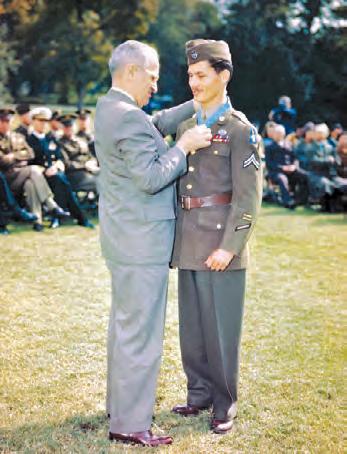
October 12, 1945


WBy Rabbi Shraga Freedman
hen I was learning in Lakewood, Rav Matisyahu Salomon used to remind us regularly, “As you rush to seder every day, keep in mind the ultimate purpose of your Torah learning. You are coming to the beis medrash to spend four hours immersed in learning, in order to
Rav Matisyahu adds that this is also how we can understand the concept of derech eretz kadmah
l’Torah . How is it possible for anything to take precedence over Torah? The answer is that the purpose of Torah study is to bring about kiddush shem Shamayim . A person who lacks derech eretz cannot create a


in behaving in an upright, refined way. A person who fails to behave appropriately brings disgrace to Torah study and creates a chilul Hashem , for Hashem gave us the Torah as a vehicle for the attainment of perfection.
The power of a ben Torah to cre-
Rabbi Shraga Freedman is the author of Sefer Mekadshei Shemecha, Living Kiddush Hashem, and A Life Worth Living.
Email LivingKiddushHashem@ gmail.com for a free sefer. Visit LivingKiddushHashem.org for more resources


















By Sara Rayvych, MSEd
Aperson can have everything in the world yet never be happy if they don’t appreciate and feel gratitude for those gifts. Each day, countless individuals will help us in different ways –most never expecting anything in return.
Chessed is one of the pillars that support the world, and it’s truly the only way to survive as a kehilla.
Hashem gives us gifts on a daily basis – including life itself – yet we take these for granted. The truth is that it’s impossible to fully appreciate every big and small thing Hashem does for us. The greater we can appreciate these divine presents, the better our lives will be.
While we would like to think gratitude is something we should naturally feel, the opposite is often the case. We come into this world as complete takers, totally dependent on the care of others. This is ultimately a strength because it’s this continuous care that builds feelings of security and love in the newest family member. As crucial as these early moments are, it’s important to transition out of expecting the world to be handed to us.
We are surrounded by a society that is becoming ever more entitled. One small example is “thank you” cards. These once mandatory ways of showing gratitude have nearly become extinct. Within a few years, the gold standard will soon be a flippantly tossed, “Yo, thanks.” For many, the feeling is everyone owes them, while they themselves have no personal responsibilities. As these poor middos filter into our communities, parents need to be ever vigilant to be mechanech their children in proper behavior.
Gratitude isn’t as much a set of specific actions as it’s an attitude that pervades the household. As with all areas, parents set the tone. We can either assume we’re owed everything or appreciate what we receive. When we build an environment
of gratitude, we are encouraging the same in our children.
While I assume it’s a given, it’s worth mentioning a few of the many people we should appreciate in our daily lives. This includes school staff, healthcare providers and carpool buddies. We can thank these individuals directly but also speak about our appreciation for them within our children’s presence. “Wow, that nurse really went above and beyond in my care.”
We often pass people and never think to show appreciation for what they do. The overworked package delivery guy, cashiers, security staff and secretaries all assist us yet seemingly fade into the background. Our children will notice when we take the moment to thank them. It’s often these individuals that get disregarded because they seem to “just be there.”
Many individuals have a beautiful custom of writing, saying, or mentally listing what they are grateful for each day. It’s surprising what comes up when this is done routinely, and it’s something that can be easily instituted with children, such as during the dinner or bedtime routine. Children should not be forced if they are uncomfortable, and we can simply tell them some of our “daily gratitudes” if that is easier for them. In general, expressing gratitude should be encouraged but not forced.
Kibbud Horim
Children do have a mitzvah of kibbud av v’aim, but that doesn’t detract from our need to thank them for their help. While we certainly need to appreciate their unsolicited assistance, we also need to acknowledge when they respond positively to our request.
I humbly suggest we should even say “thank you” when children don’t respond appropriately right away but eventually follow through. We are recognizing what they have done, not harping on what they should have done initially. The chinuch to

listen when first asked is a different issue and should be addressed separately.
Beyond teaching gratitude, we may be further encouraging them in their mitzvah of kibbud horim. We would like to think they will want to honor us just because of the mitzvah (or gratitude for all we’ve done for them), but kids are not yet so altruistic. They are unlikely to help if we’re condescending or ignoring their contribution. Alternatively, they will be eager to help when they feel the love and gratitude we express for their assistance.
Demonstrating gratitude is one step towards educating a child in hakaras hatov. The next step is to be someone our child wants to emulate. It’s only by having a close bond with our child that will make them want to follow in our derech.
Parents can easily become frustrated when children show a lack of gratitude for their adults’ efforts. The list becomes endless when we begin to describe all we do for them. The top of the list begins with giving them life. Let’s see them birth themselves! We met their every need from their earliest moments. We can’t even begin to count the number of sleepless nights and times we comforted a sick child. We provide food, shelter, healthcare, clothing, shoes and even toys. It’s not only foolish when they fail to recognize our contributions – it’s painful!
The previous paragraph could easily be used to describe how many behave towards Hashem. We don’t want this to de -
scribe ourselves, and we all need to show gratitude to the ultimate Source. Everything only exists by the will of Hashem and is designed to be for our benefit.
Our acknowledgement of Hashem’s beneficence not only prevents us from being personally ungrateful, it also provides a blueprint for our children. Our children will be infinitely happier when they can appreciate all the small gifts that others ignore. The ability to walk and breathe, food in the fridge and heat in the winter are all necessary for our survival yet are mentally disregarded and rarely thought of further.
Many of our tefillos are dedicated to expressing this very sentiment. An entire section of the Amidah is dedicated to thanksgiving, and Modim is the one area of Shemoneh Esrei that everyone says personally during chazaras hashatz.
Appreciating Hashem’s gifts will give another benefit. They will be able to feel Hashem’s continuous love for them, as well as a recognition of their self-worth. When someone realizes just how much they receive on a daily basis, they can’t help but be overwhelmed with feelings of being loved from Above. Similarly, we must each be someone very special if Hashem feels we are worthy of all these gifts.
Sara Rayvych, MSEd, has her master’s in general and special education. She has been homeschooling for over 10 years in Far Rockaway. She can be contacted at RayvychHomeschool@gmail.com.


















Honorable Mentions Honorable Mentions

















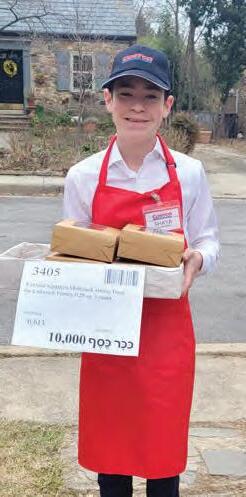
























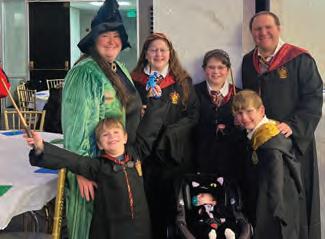












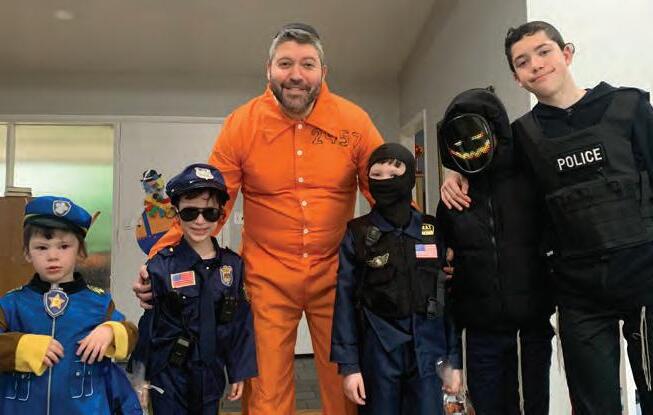


















Bleach really does ruin clothing.
Your knees ain’t what they used to be.
Children do eat in the bathroom.
If you think the sanitation workers are going to come tomorrow, they won’t.
You can never have enough old undershirts.

Macaroons have no expiration date.


So that’s where the matzah from the eruv tavshilin went!
You have more shoes than DSW under your bed.
Your kids have more sport water bottles than the route at the NYC Marathon.
You will never end up using those ketchup packets that you collected “just in case.”
The junk drawer will always look like the junk drawer no matter how neat you try to make it.

That thing you should have thrown out last year, you should throw out this year, but you’ll throw out next year… yeah right.

No, you will never remember how to put the fridge back together again.


Yes, you will never have enough silver foil. When needed most, you will be unable to tear off a paper towel using just one hand.

Despite the three containers full of varied type of nails, you will certainly have to visit the hardware store at least three times before yom tov to get just the right nail for different projects.

Those counter covers really are ugly; it’s not your imagination.

Going away for Pesach is totally not overrated.
A window cleaner is cleaning a window on the 25th floor of a skyscraper. He suddenly slips and falls. He has no safety equipment and nothing to soften his fall, but he is not hurt at all. How did that happen?

Answer: He was cleaning the inside of the window, inside of the building.
1. Which of the following is not in Mr. Clean Magic Eraser?
a. Melamine
b. Formaldehyde
c. Sodium Bisulfite
d. Mustard
2. Which two common household products should you never mix together?
a. Tired children and house chores
b. Bleach and ammonia
c. Vinegar and baking soda
d. Detergent and fabric softener
3. What should you put around an ink stain on your shirt to prevent the ink from spreading?
a. Vaseline
b. Cinnamon
c. An ice cube
d. Hairspray
4. John S. Thurman invented his gasoline powered vacuum cleaner in 1899, and some historians consider it the first motorized

vacuum cleaner. He had a horse-drawn door-to-door service vacuum system in St. Louis. How much did he charge per visit?
a. Thirty-five cents
b. One dollar and twenty cents
c. Four dollars and fifteen cents
d. Twelve dollars
5. Which of the following is not a common component of dust?
a. Skin cells
b. Decomposing insects
c. Rubber
d. Dirt
e. Lint
6. Despite his immense success, Mr. Clean didn’t receive a first name until 1963. That year, Procter & Gamble staged a “Give Mr. Clean a Name” contest. The winner was offered either $30,000 in cash or a $30,000 fully furnished house. Can you guess Mr. Clean’s winning first name?

a. Veritably b. Cornelius
Yankel goes to see his supervisor in the front office.
“Boss,” he says, “we’re doing some heavy Pesach cleaning at home tomorrow, and my wife needs me to help with the attic and the garage, moving and hauling stuff.”
c. Major d. Jackson
Answers:
1-D
2-B Mixing bleach and ammonia causes dangerous fumes.
3-A
4-D
5-C Just in case you are freaked out by skin cells being part of dust, here is how it works: The average person loses between 50-100 thousand skin cells every minute. Those flakes of skin accumulate in carpets and furnishings, dry out, and then are lifted into the air by drafts or air currents. Breathe in, breathe out…
6-A Veritably (and then he wonders why people call him by his last name all the time?!)
5-6 correct: Veritably Goldberg, you are pretty good!
3-4 correct: You are not bad. Your mind is just a bid dusty…all of those skin cells piling up.
0-2 correct: You should really stop drinking Windex.
“We’re shorthanded, Yankel,” the boss replies. “I can’t give you the day off.”
“Thanks, boss,” says Yankel. “I knew I could count on you!”


I was left with the strong sense that I could have gone much further.
- Israeli theoretical physicist Yehuda Ashkelon, who recently set a new record in memorizing the mathematical constant Pi by recalling and reciting 25,333 decimal places, on whether or not he should memorize more digits of the infinite number

The other day, you were asked a question by another outlet: Can you guarantee that we’re not going to have a recession?
-Maria Bartiromo to Treasury Secretary Scott Bessent
Yeah. Well, look, it was a silly question. Can you guarantee there is not going to be a recession? I can’t guarantee anything. I can’t guarantee that the journalist who asked me the question that her news program is going to be on in a year. But, what I can guarantee you is that there is no reason we need to have a recession.
-Bessent, in response
“I’m from Brooklyn. Sometimes it helps me, sometimes it hurts me. But I know one thing: If I tried not to be from Brooklyn, I’d be worse than whatever I am.” Well, that’s a synonym for Jewish. So I was always Jewish. But it was never that vital to my career.
-Senator Chuck Schumer in an interview with The New York Times this week
We [Democrats] just assumed we were on the side of working people, so they would naturally assume it, and it didn’t happen. We lost them because they didn’t think we cared about them enough. We always did care about them, but we didn’t convey it. So now, as you said, we’re learning to convey in different ways.
- ibid, when asked how Democrats lost this year’s elections

Give us back the Statue of Liberty. It was our gift to you. But apparently you despise her. So she will be happy here with us.
-Raphaël Glucksmann, a member of the European Parliament and co-president of a small left-wing party in France, demanding that the U.S. gives back the Statue of Liberty to France
My advice to that unnamed low-level French politician would be to remind them that it’s only because of the United States of America that the French are not speaking German right now. They should be very grateful.
- White House press secretary Karoline Leavitt when asked to comment about Glucksmann’s demands
The astronauts were only supposed to be there for eight days, and they’ve been there for almost ten months. So, obviously, that doesn’t make any sense. SpaceX could have brought the astronauts back after a few months at most, and we made that offer to the Biden administration. It was rejected for political reasons, and that’s just a fact.
- Elon Musk, SpaceX founder, after his company brought back astronauts Butch Wilmore and Suni Williams this week after they had been left in space for 286 days


I have to just, speak of inflation – I love these socks. What’s with these socks? I’m trying to stay focused, but I’m very impressed with the VP’s socks.
- President Donald Trump during an Oval Office meeting with the prime minister of Ireland, ribbing Vice President JD Vance’s cream-colored socks adorned with green shamrocks
Schumer is a Palestinian as far as I’m concerned. He’s become a Palestinian. He used to be Jewish. He’s not Jewish anymore. He’s a Palestinian.
- President Trump during an Oval Office meeting



Moderated by Jennifer Mann, LCSW of The Navidaters

We have a boy who is ben bayis by us, a very solid incredible guy whom we’ve watched grow into the amazing talmid chacham he is. He has a lot to show for himself, as he is successful, good-looking, solid frum, and has great middos.
He’s been shidduch dating for a few years unsuccessfully. Now, he is dating a girl for a couple months, and we’ve never seen him so happy. But my husband and I are scratching our heads about it. This girl is a BT who has an unsavory past and negative reputation. Much of her old life is open for all to see on social media. She claims to have changed, but then why wouldn’t she have gotten rid of her old media accounts/pictures, etc.?
We haven’t given our opinion on her as he hasn’t asked, but we’re wondering if we should intervene. Do we assume he knows and is fine with it?
Any advice would be appreciated.
The Cohens*
Disclaimer: This column is not intended to diagnose or otherwise conclude resolutions to any questions. Our intention is not to offer any definitive conclusions to any particular question, rather offer areas of exploration for the author and reader. Due to the nature of the column receiving only a short snapshot of an issue, without the benefit of an actual discussion, the panel’s role is to offer a range of possibilities. We hope to open up meaningful dialogue and individual exploration.

Dear Readers,
We want to offer YOU an opportunity to be part of the discussion! Please email us at MichelleMondShadchan@gmail.com, subject line “reader’s response,” if you would like to participate in the new “A Reader’s Response” columnist spot. We will send you a question and publish your answer in an upcoming Navidaters edition.
If you have a question you would like the Navidaters to answer, please reach out to this email as well.
Looking forward!
Michelle, the “Shadchan”
Rebbetzin Lisa Babich
Hi and thank you for your question. I definitely hear your concerns. I think if this was someone who was a ben bayis by me I would address it cautiously. What do I mean by that? I would gently probe/guide him and ask, “How is it going? How do you feel about your different backgrounds? Are you sensing nice middos? Have you heard good things about her?” I would do this in order to open the discussion and hear from him. This is called gentle guidance. He is an adult and someone who has been dating for a few years. He will want and need to make his own decisions; however, asking questions that make him think and that lend themselves towards dialogue between the three of you can be very helpful.
I also imagine that at some point if things continue to go well, he will want you to meet her. It could be once you see her in person you will have a lot more clarity on who she is. If he then asks you your opinions you can be honest about what you thought, but you may be surprised that your opinions and feelings change once you see her in person.
Guiding someone is a big responsibility and is never easy but there is a balance that has to be found. You want to guide them while also acknowledging that they aren’t a child. If they are adult enough to get married, then they are also adult enough to ultimately make
their own decision with your help and assistance.
Hatzlacha!
Michelle Mond
This must be so difficult for you to navigate! Fortunately, your ben bayis sounds like a smart young man who can make decisions for himself. I understand your concern about the girl he is dating. You wonder if she is truly genuine or just putting on a show for him. That is a valid concern but realize that a show like that can only go so far; her true colors will eventually show. If he is smart and with it, he will notice any disingenuous signs as time goes on.
The most important thing you can do is to encourage him to take his time. All too often, singles think they need to make the decision by date number “X,” which adds way too much pressure to an already stressful situation.
Another thing you can do is make sure he is aware of the obvious. If her social media accounts are still up and active from her “previous” life, simply ask him, “By the way, have you checked out her social media accounts? It looks like they’re still active.. I thought you should know.” You are not giving away any big secrets by saying this, as it is public and out in the open. He can then discuss it with you and ask solicited advice. If it is a surprise to him, he will
then be able to make his own decision about whether this concerns him.
It is so hard to sit on the sidelines, I know. But you must recognize that he is the one who has to ultimately make this decision.
Dr. Jeffrey Galler
Ah, the age-old conundrum: To intervene, or not to intervene? That is the question.
My initial reaction was to not intervene and to recall the very appropriate Hebrew expression:
“ Mei’olam lo hitztaarti, al davar shelo amarti.” Meaning, you will never regret restraining yourself from saying things you might later wish you hadn’t.
But then, a friend explained to me that the term “ben bayis” doesn’t merely mean that the young man is a frequent house guest; it could signify that you are almost like a quasi-parent.
That would explain why you do seem to know a lot about him and do seem to be very sensitive to his needs and feelings. So, on the one hand, it’s understandable that you care about him and want to get involved and be helpful.
But, on the other hand, he is an adult who can make his own decisions, he didn’t ask your opinion, he seems very happy right now, and anything you say at this point can ruin your relationship with him.
So, what to do? I have two possible suggestions.
First, you can invite the young man and his girlfriend for a Shabbos meal. There, you can observe them and their interactions. You can express how much you admire and appreciate her becoming a baal teshuva. And, you might, very, very subtly, mention how a BT acquaintance had discussed the challenges of modifying his social media presence to more accurately reflect his current religious status.
Or, second, if you are really, really concerned and troubled about the girlfriend, consider calling the young man’s
Guiding someone is a big responsibility and is never easy but there is a balance that has to be found.
rebbe or rosh yeshiva. Make sure that he promises to keep your call confidential. Make it his responsibility. Let the rabbi decide whether he, personally, should, or should not, intervene and discuss the situation with his student.
These suggestions can allow you to feel that you not only acted responsibly, but also avoided the potential negative consequences of ruining your relationship with him.
And, you can avoid the indecision that plagued Hamlet, in Shakespeare’s play. Prince Hamlet, who is consumed by overthinking the responsibilities and consequences of his actions, famously contemplated “To be or not to be” and was tormented by inaction.
A Divorced Reader
Dear Mr. and Mrs. Cohen, I’m going to be direct, because I’ve been in his shoes. I got married thinking I knew everything I needed to know. I was happy, in love, and convinced that whatever concerns people might have had were either exaggerated or irrelevant. And then, after the wedding, reality hit. There were things I should have known, things that would have made a difference, but no one told me. Maybe they didn’t want to interfere. Maybe they thought I wouldn’t listen. Maybe they thought it wasn’t their place. But I can tell you now, I wish
someone had spoken up.
I’m not saying this girl isn’t a good person or that people don’t change. But some pasts come with weight, and some choices leave a lasting impact. The fact that hers is still visible, still public, is something he needs to fully understand. It’s not about whether she’s a good person today. It’s about whether he’s thought about how this might affect their future, their kids, their community, and the way people will treat them as a
couple. It’s easy to say none of that matters when you’re happy. But things that don’t seem like a big deal in dating can become a big deal in marriage.
That said, here’s the tough part. If you bring this up, there’s a good chance he’ll get defensive. If he’s already decided she’s the one, anything you say could feel like an attack. But if he truly doesn’t know the full picture, then you have to ask yourselves if you’re okay with staying silent.
Dear Mr. and Mrs. Cohen, First of all, I really want to validate where you are. This is a tough spot, and I think a lot of people, maybe more than we even realize, find themselves in situations like this. You care deeply about someone, you know something that might be relevant to their future, and you’re left wondering: do I say something? Do I stay out of it? What’s my responsibility here?
There’s no simple answer because both sides of this are valid. On one hand, we all know stories of people who got married and later said, “I wish someone had warned me.” But we also know that the same people, if they had been warned, might have dismissed it, minimized it, or even resented the messenger. So how do we weigh that?
I think the bigger, philosophical question here is whether we have a duty to share what we know or whether we respect people’s right to make their
own choices, even if we think they might be making a mis - take. It’s almost like the psychological concept of duty to warn, but in the world of relationships, the lines are so much blurrier because this isn’t about something as clear-cut as safety. It’s about perception, values, and how much someone’s past really defines them.
And then, there’s another piece. What does it say that she hasn’t hidden her past? In the world of shidduchim, where people are often coached to keep things under wraps, to wait until the seventh date to reveal something so the other person is already emotionally invested, here’s someone who, for whatever reason, has not erased her history. That doesn’t mean she’s proud of it, but it does mean she’s not pretending to be someone she’s not. And in a system that often pushes people toward secrecy and shame, is there something admirable
If it were me, I’d want to hear it from someone I trusted, someone who came to me out of love, not judgment. Maybe I wouldn’t have wanted it then, and hindsight is 20/20. But maybe something like, “We love you, we see how happy you are, and that’s all we want for you. But we’ve been struggling with whether we should say something, because if we were in your shoes, we’d want to know. If you already do and you’ve made peace with it, then we’ll respect that completely.”
If we write off everyone who has made mistakes, there won’t be many people left to marry.
If he knows everything and still moves forward, that’s on him. If he doesn’t and no one says a word, then that’s on all of you. Either way, this has to be his choice, but at least make sure it’s an informed one. I wish someone had done that for me.
about that?
But back to your role. What will allow you to live with yourselves, regardless of how this plays out? If you say nothing and it turns out he was unaware, will you regret it? If you do say something and he gets defensive, will that feel like you’ve done your part, or will it hurt the relationship? If you were in his shoes, would you want to know? And maybe more importantly, would you have actually listened?
Whatever you decide, it has to come from a place of love, not judgment. If you do bring it up, it might sound something like:
“You know how much we care about you, and we’re so happy to see you happy. We’re not here to tell you what to do. We wouldn’t even know what to say. We just found ourselves in a place where we weren’t sure whether to speak up, and since we love you, we didn’t want to stay silent if this was something you wanted
to process. If you’d rather we don’t bring it up at all, we’ll respect that completely.”
And then it’s in his hands. Because at the end of the day, this is his life, and he has to be the one to own his choices. And if he knows everything and still chooses her, that’s his right. People have pasts, and sometimes those pasts make them into extraordinary people. If we write off everyone who has made mistakes, there won’t be many people left to marry.
I don’t think there’s one right answer here. It’s a question of values, self-trust, and deciding what kind of role you want to play in this person’s life, both now and in the future.
Whatever you do, I hope you handle it with grace, dignity, and respect, both for him and for her. Wishing you clarity in whatever path you take.
Warmly, Jennifer
Jennifer Mann, LCSW is a licensed psychotherapist and certified trauma healing life coach, as well as a dating and relationship coach working with individuals, couples, and families in private practice at 123 Maple Avenue in Cedarhurst, NY. To set up a consultation or to ask questions, please call 718-908-0512. Visit www.thenavidaters.com for more information. If you would like to submit a dating or relationship question to the panel anonymously, please email JenniferMannLCSW@gmail.com. You can follow The Navidaters on FB and Instagram for dating and relationship advice.
By Rabbi Azriel Hauptman

Readers of this column are pre ing the locks endless times, or taking internal and invisible that you would never know they have OCD. Moreover, due to many misunderstandings about OCD, they themselves might not know that they have OCD. However, their OCD is just as painful and distressing as “classic” OCD.


Before we take a deep dive, let us first review the basics of OCD. OCD is composed of two parts: the obsessions and the compulsions. Obsessions are unwanted thoughts or fears, and compulsions are repetitive behaviors that one does in an attempt to diminish the obsessions. In the well-known OCD of handwashing, the obsession is the fear that there might be harmful and dangerous germs on one’s hands, and the compulsion is the constant washing in an attempt to eliminate this fear.

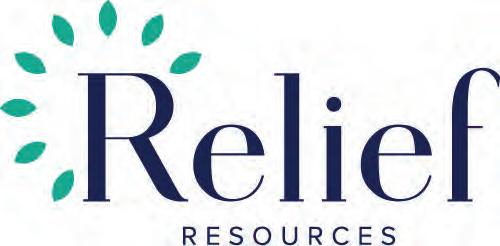
OCD can also occur if someone has existential questions. Although such questions are highly valued when part of a genuine intellectual pursuit, it becomes a mental illness when one’s brain gets so obsessed with the question that the quest to answer it leads to unending brain loops, insomnia, and acute mental distress.
Since these types of OCD do not resemble the more well-known types of OCD, one can be suffering for years and not be aware that he or she has a diagnosable and common disorder that when properly treated can be helped tremendously.




Sometimes, the compulsions are not as self-evident and may be completely mental in their nature. This is common in a subtype of OCD called Harm OCD. Some people have an intrusive thought that they might harm somebody, especially someone who they love dearly
of this thought comes from the fact that our brains periodically spew out nonsensical thoughts that most people ignore and barely notice. But if you take that thought seriously, the thought
compulsion can be avoiding being near kitchen knives when the children are around, checking to make sure that they did not poison their child’s food, asking reassurance from other people, and even researching convicted murderers to see if they fit the profile. Paradoxically, this form of OCD often happens to the most caring and gentle people who
about their own moral character. The obsession may be a recurring thought that they are not a good person. The
for hours on end every night as they review recent events to see if they are
The method for treatment involves training oneself to tolerate a certain amount of doubt, not taking one’s thoughts so seriously, and recognizing that a thought is just a thought. This cannot be done by simply telling this to yourself. This is because once the brain has been trained over time to react in a certain way, the only way to achieve change and relief is to retrain the brain.
One of the most common modalities for treating OCD is an OCD-specific treatment known as Exposure and Response Prevention (ERP). By repeatedly exposing oneself to triggers that will bring about the obsession and then preventing oneself from responding and performing a compulsion, one can retrain the brain to not react to intrusive thoughts.
ERP is a specialty, and there are many therapists who specialize in the treatment of OCD and know how to custom tailor the implementation of the ERP for every individual client. The skillful application of ERP as part of the therapeutic process is the key to recovery.
This is a service of Relief Resources. Relief is an organization that provides mental health referrals, education, and support to the frum community. Rabbi Yisrael Slansky is director of the Baltimore branch of Relief. He can be contacted at 410-448-8356 or at



































Isaac Hakimi, 2.5






Note: Not all submission have been published. Keep sending in your artwork for another chance to be featured!

























Note: Not all submission have been published. Keep sending in your artwork for another chance to be featured!

By Naomi Nachman
I created this dish last year for Pesach for my show Sunny Side Up on Kosher.com, and it was a huge hit amongst our viewership. Just some simple, fresh ingredients along with the zest really made this dish shine.

◦ 3-4 lb. second cut brisket
◦ Zest of 2 lemons
◦ Zest of 2 limes
◦ 2-3 TBS olive oil
◦ 1 TBS kosher salt
◦ Black pepper, to taste
◦ 6 cloves garlic
◦ 2 cups cherry tomatoes
◦ 2 red onions, sliced
Place vegetables in the bottom of a large baking dish and set aside.
In a small bowl, add zest, oil, salt and pepper and mix together. Rub mixture all over the meat.
On a medium-high heat, sear the brisket on both sides till a nice crust forms.
Place meat on top of garlic, tomatoes, and onions, and cook covered for 3 hours at 325°F.
Remove from oven and cool slightly. Slice when cool.
Take most of the vegetables (leaving some for garnish) and the liquid and blend with an immersion blender to make a sauce.
To plate, take a large platter and add the sauce and place the sliced meat on top. Garnish with remaining vegetables.
Naomi Nachman, the owner of The Aussie Gourmet, caters weekly and Shabbat/ Yom Tov meals for families and individuals within The Five Towns and neighboring communities, with a specialty in Pesach catering. Naomi is a contributing editor to this paper and also produces and hosts her own weekly radio show on the Nachum Segal Network stream called “A Table for Two with Naomi Nachman.” Naomi gives cooking presentations for organizations and private groups throughout the New York/New Jersey Metropolitan area. In addition, Naomi has been a guest host on the QVC TV network and has been featured in cookbooks, magazines as well as other media covering topics related to cuisine preparation and personal chefs. To obtain additional recipes, join The Aussie Gourmet on Facebook or visit Naomi’s blog. Naomi can be reached through her website, www.theaussiegourmet.com or at (516) 295-9669.





